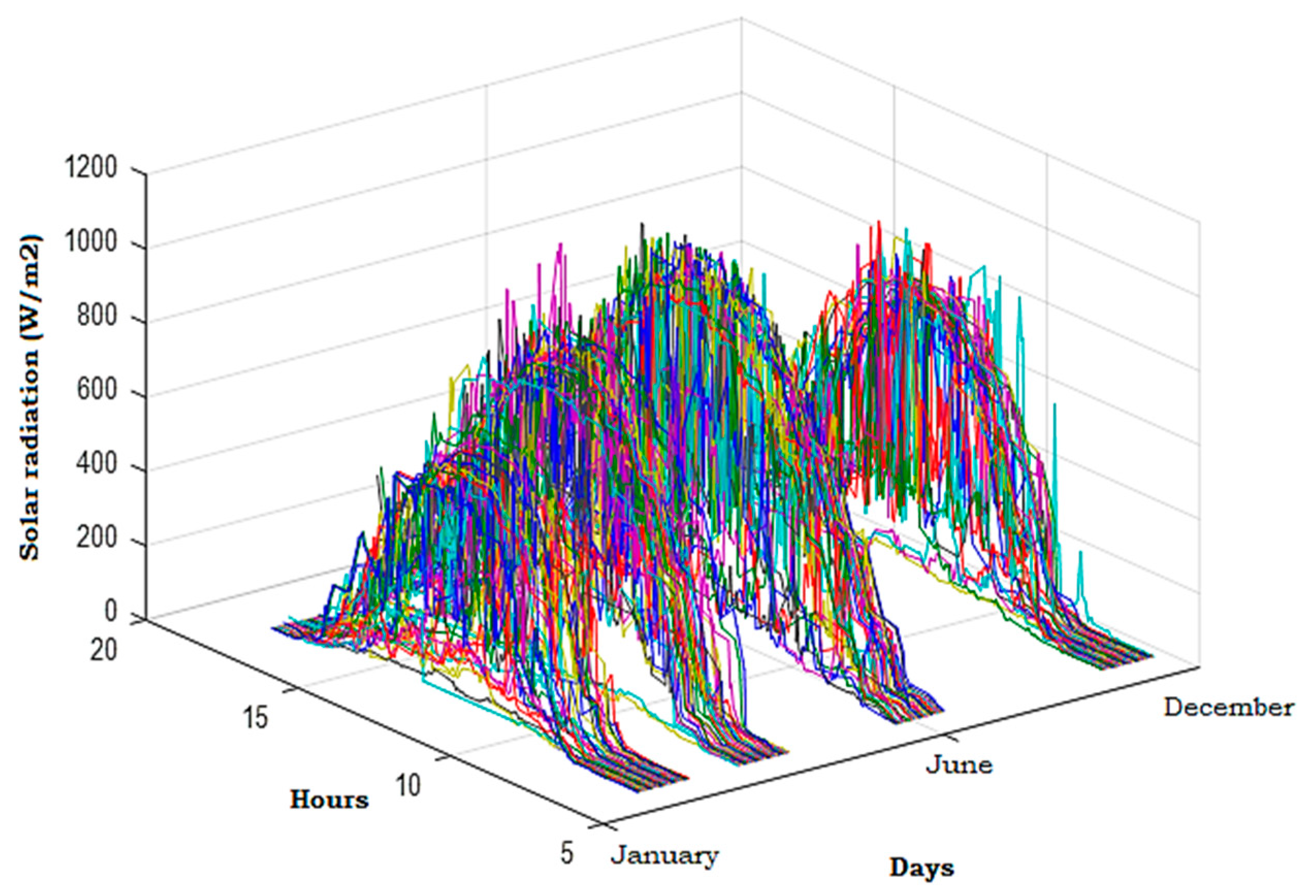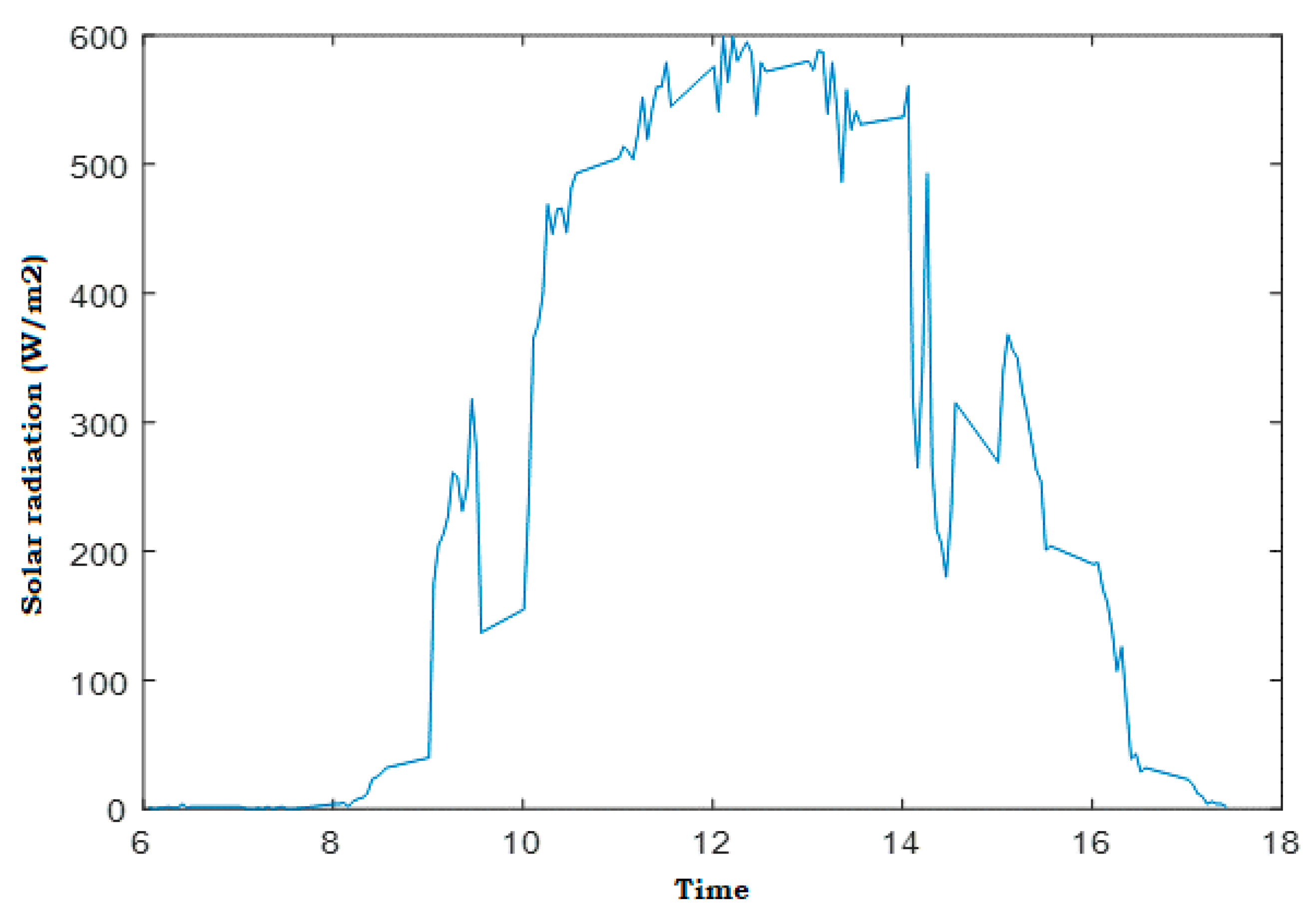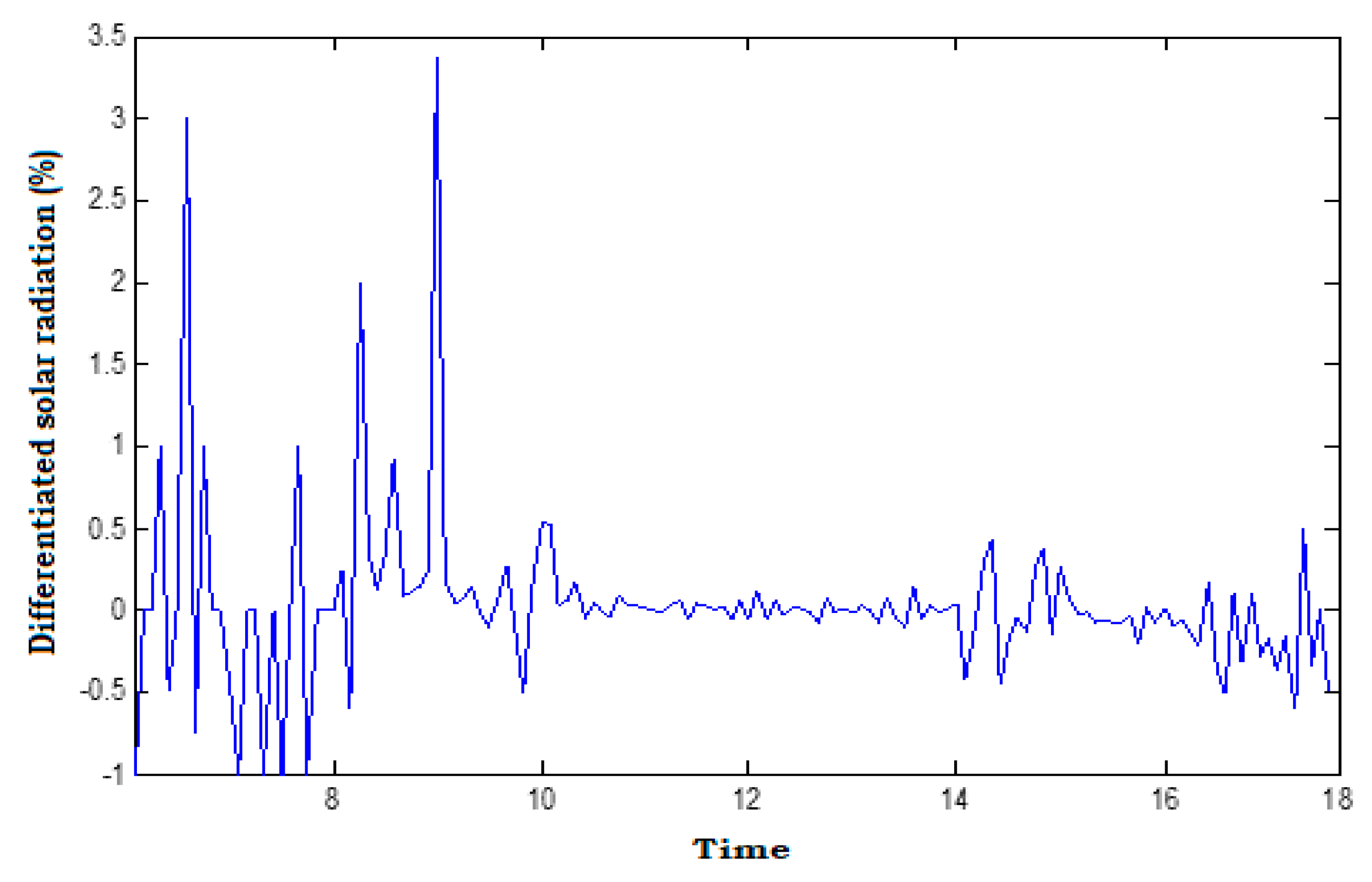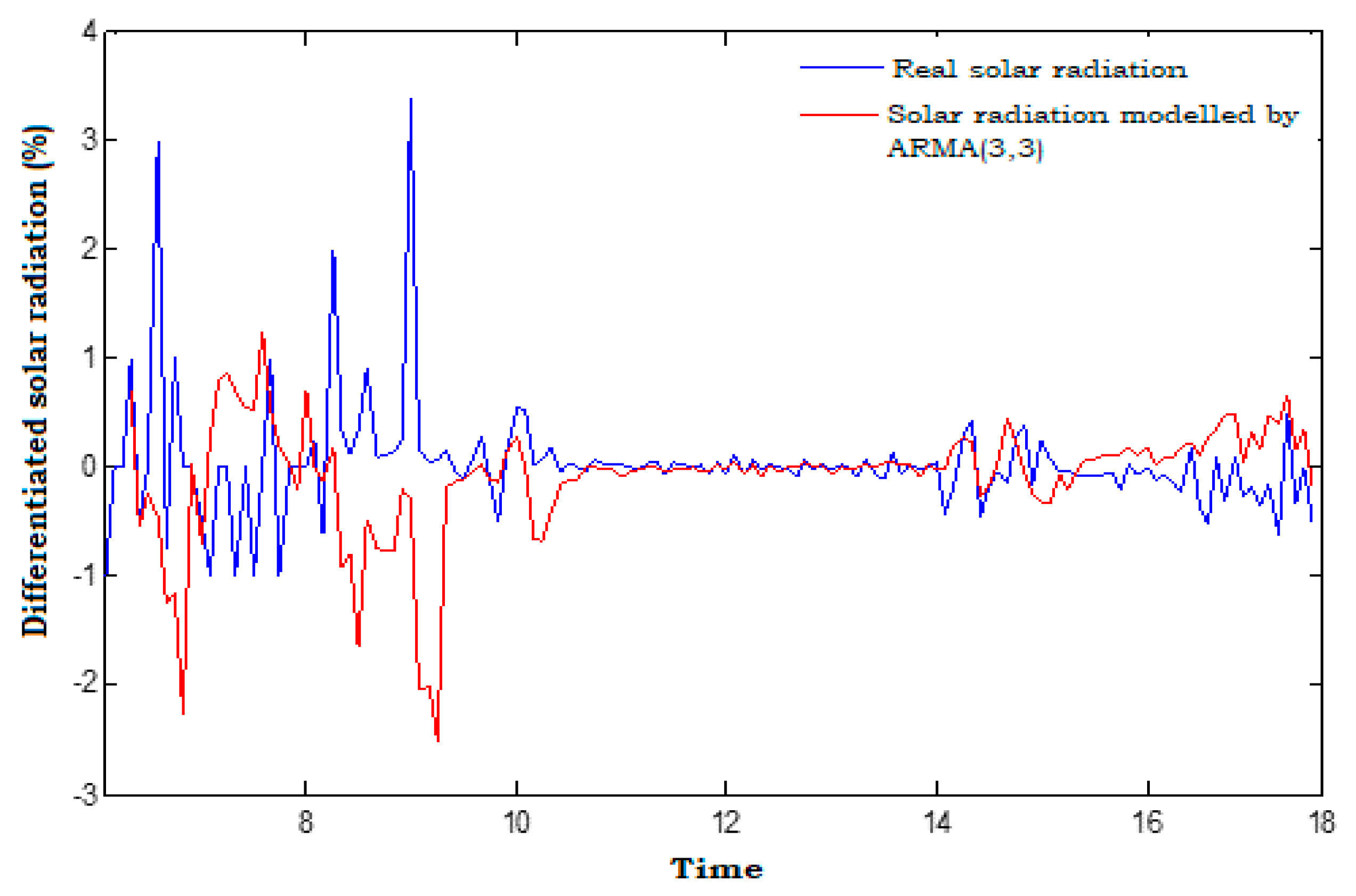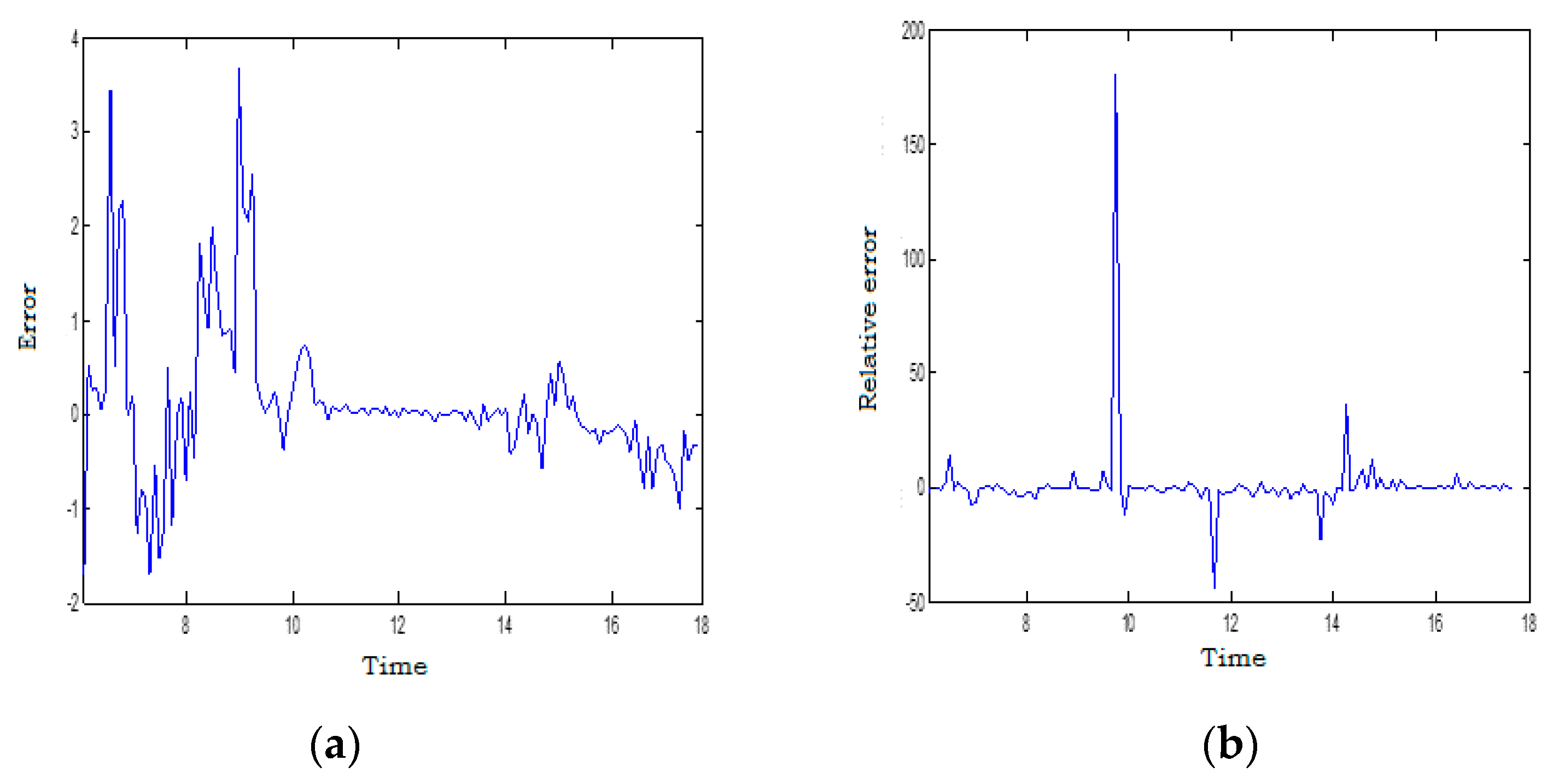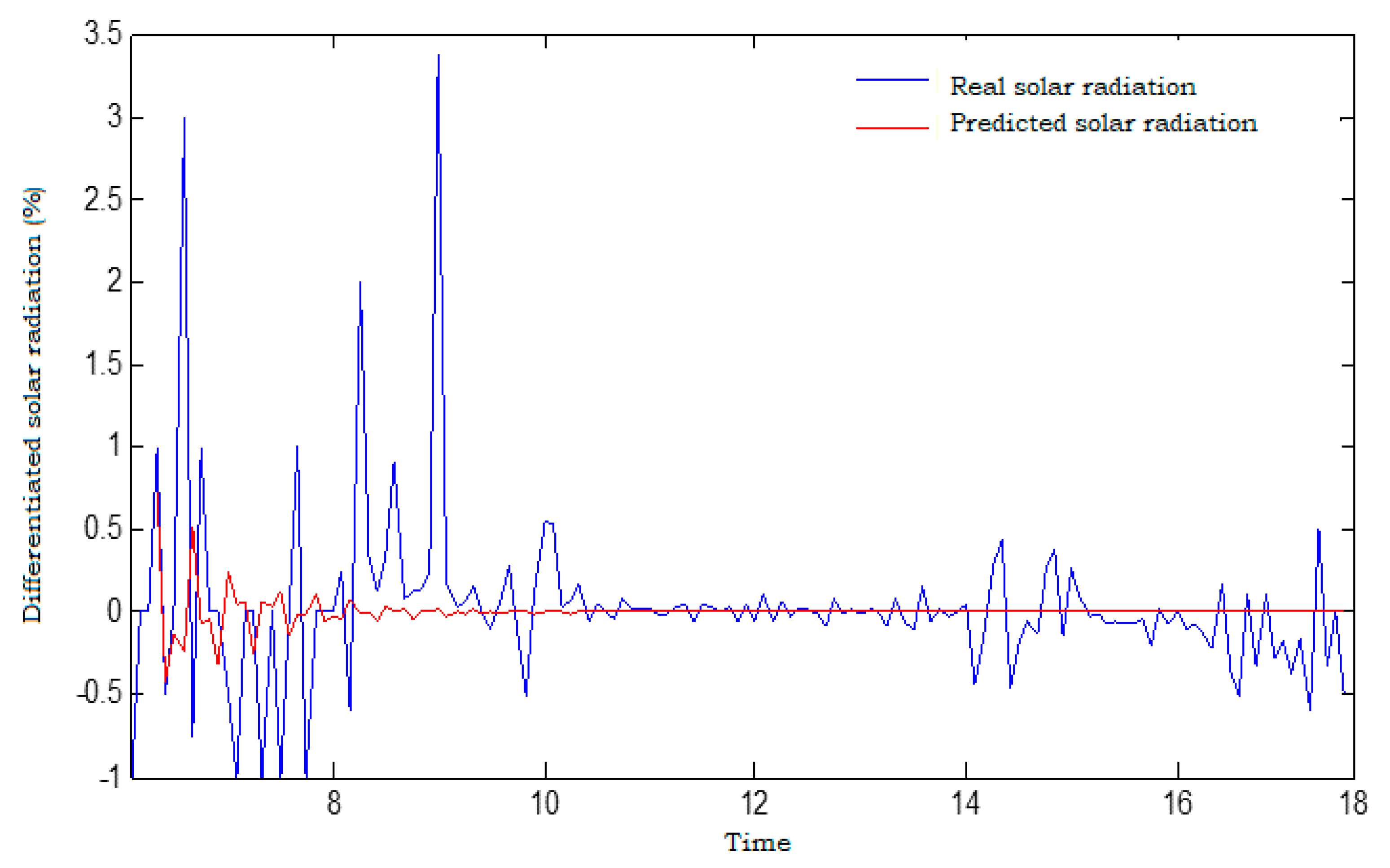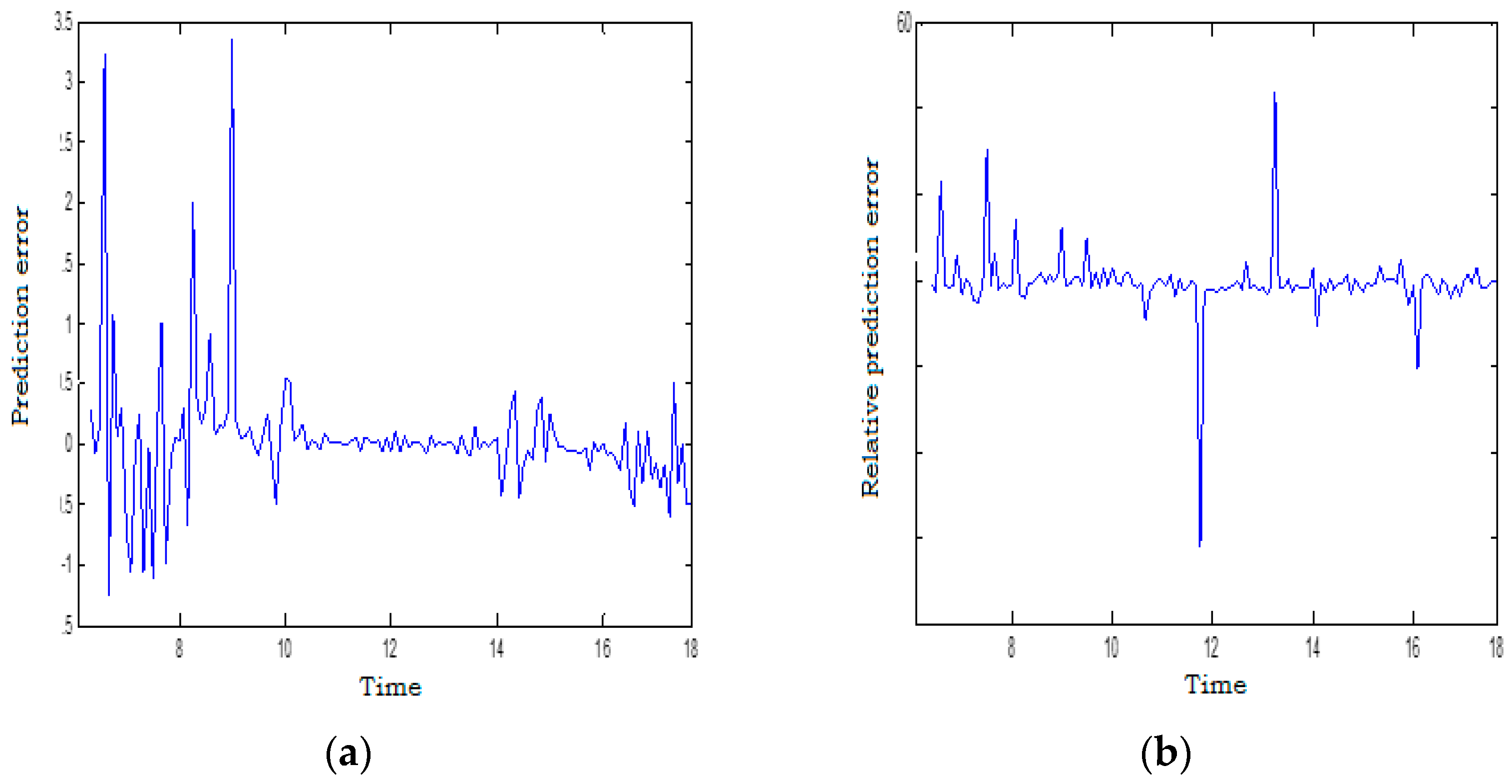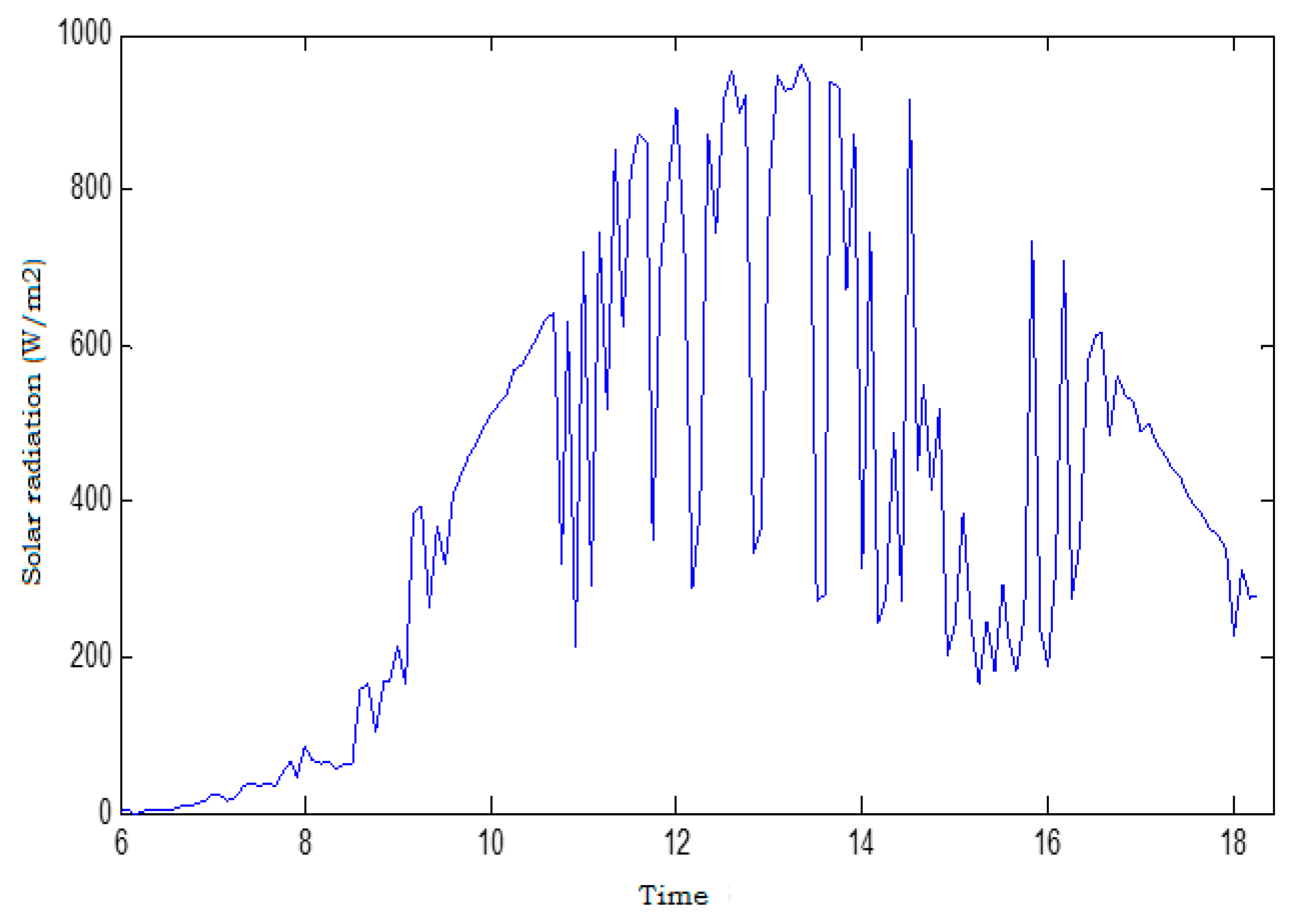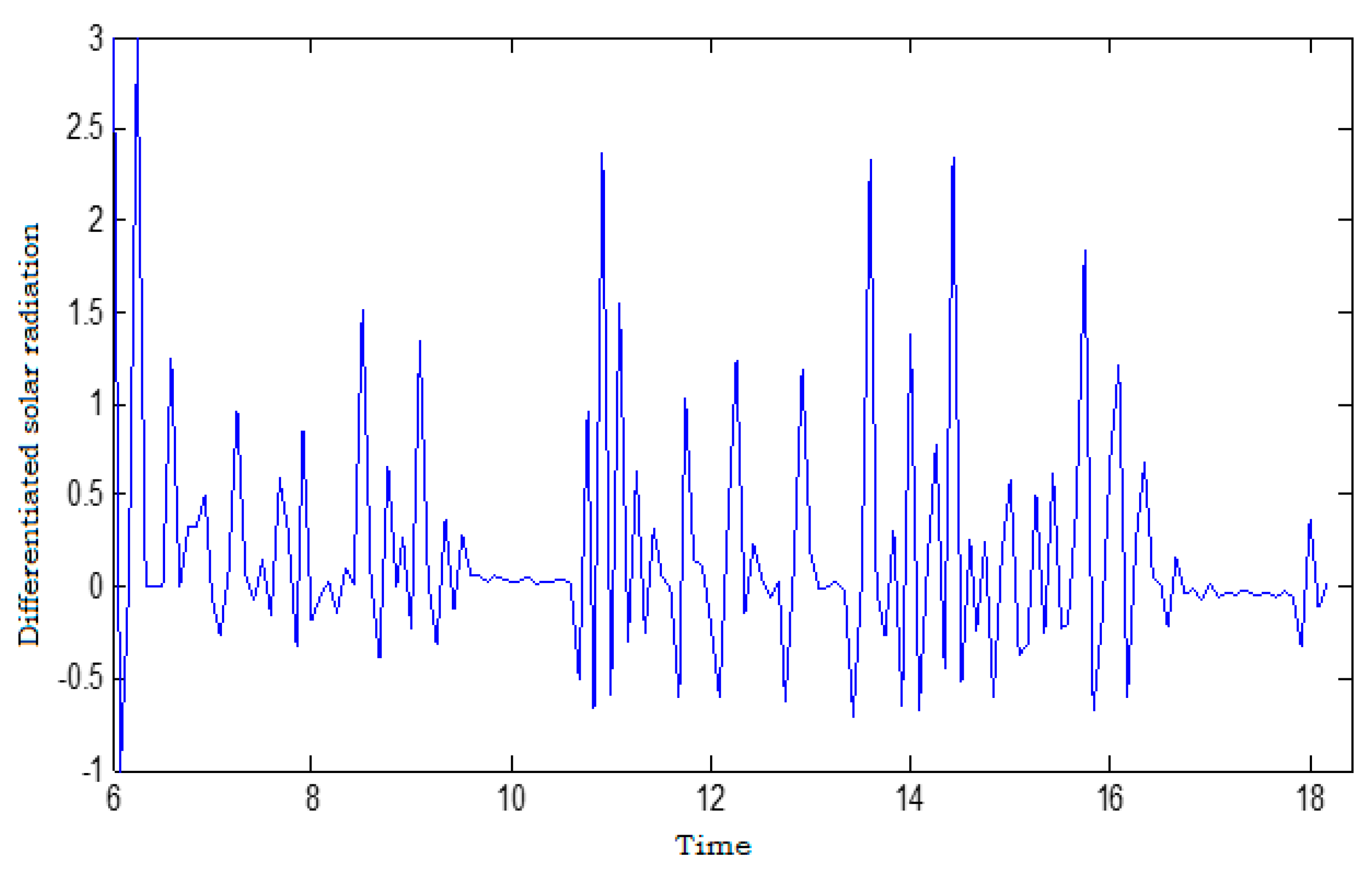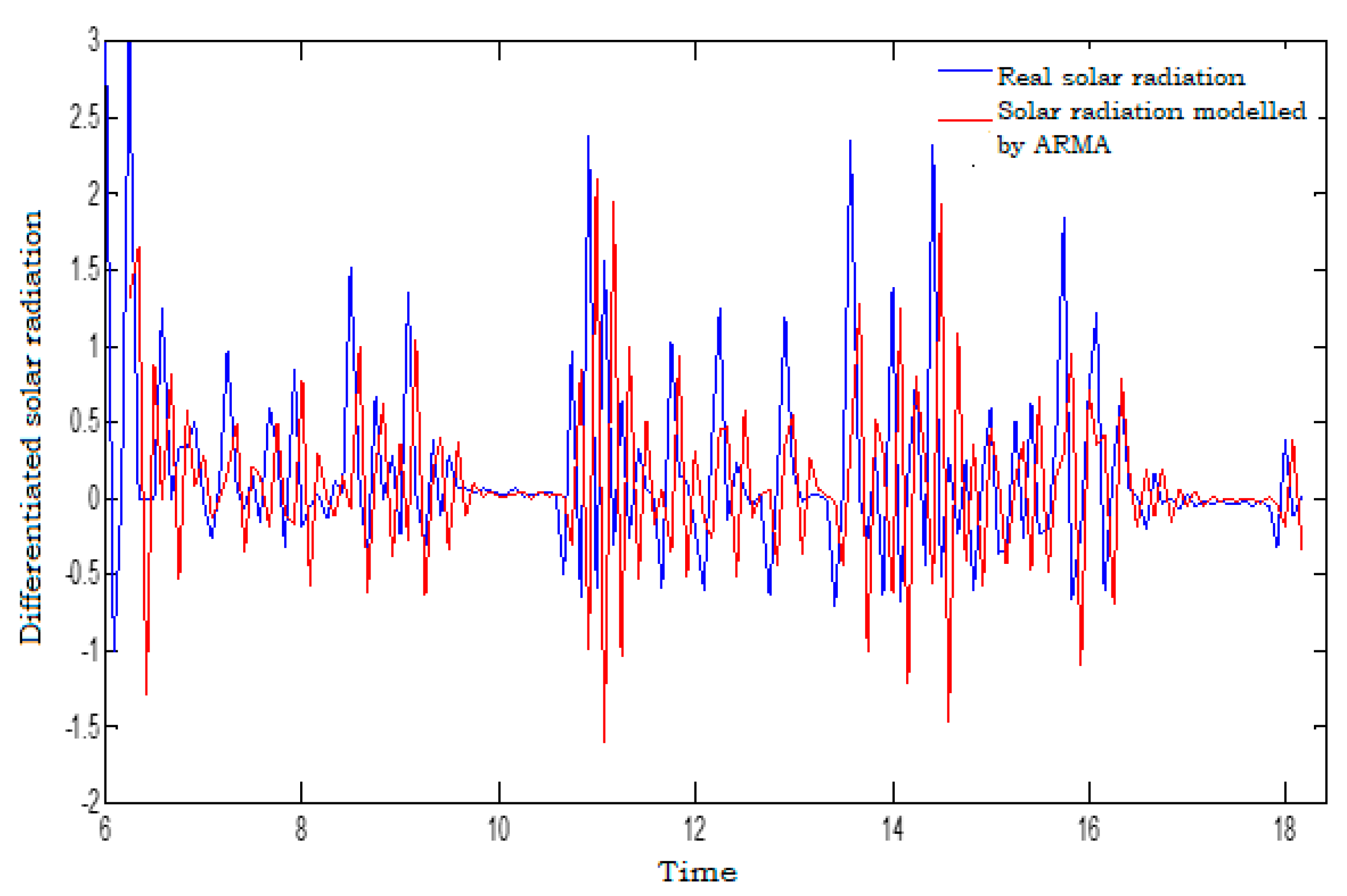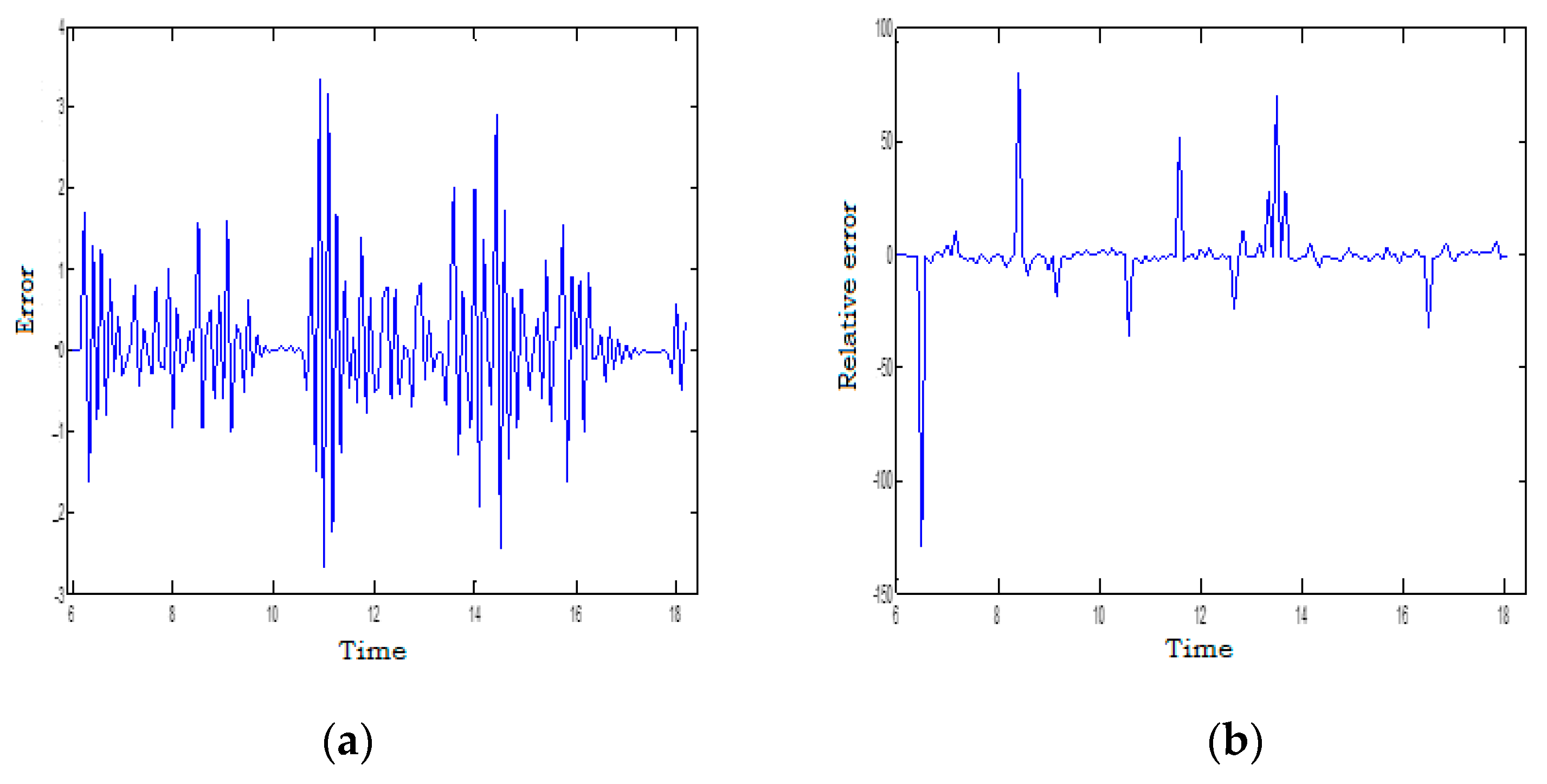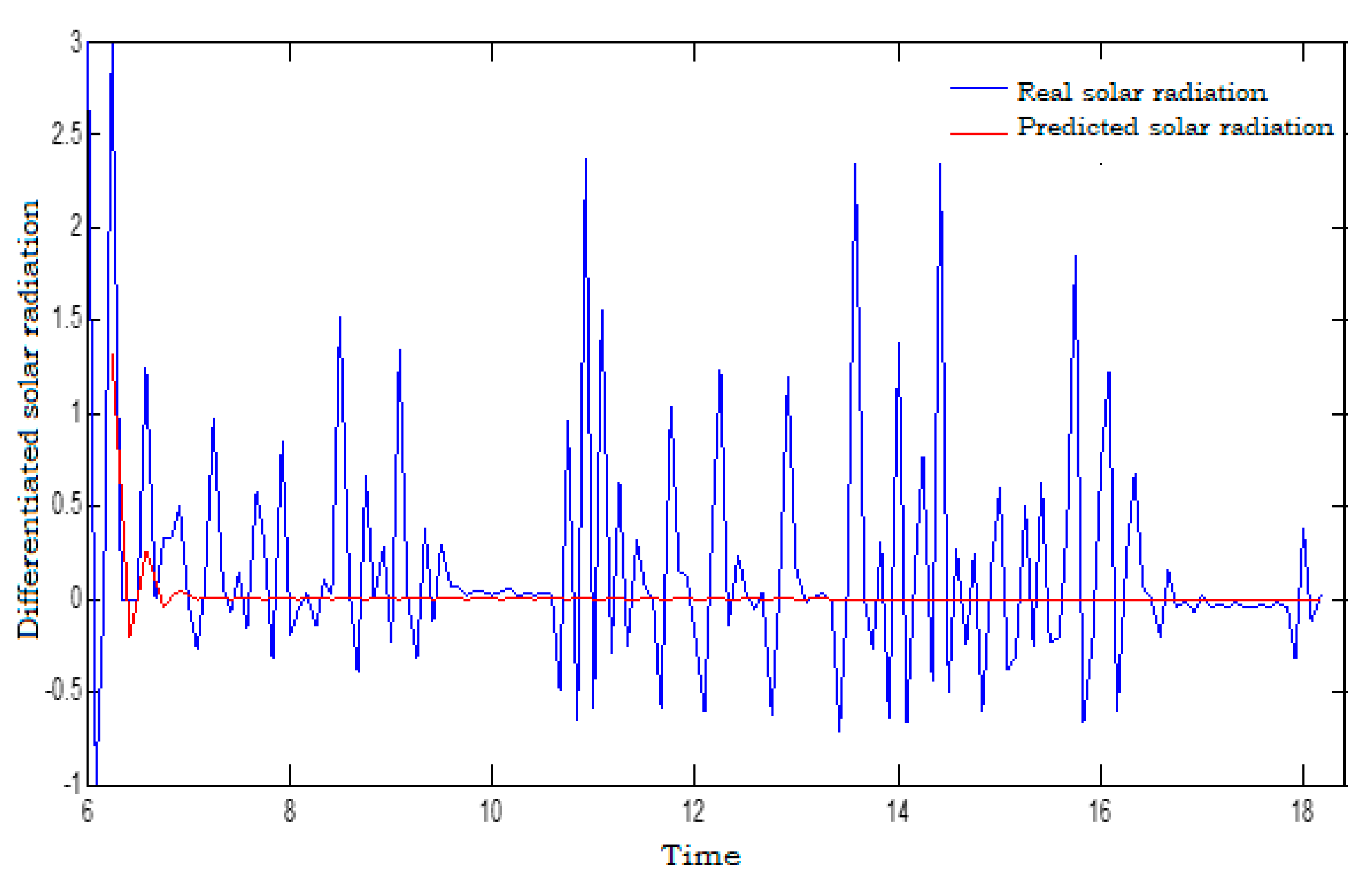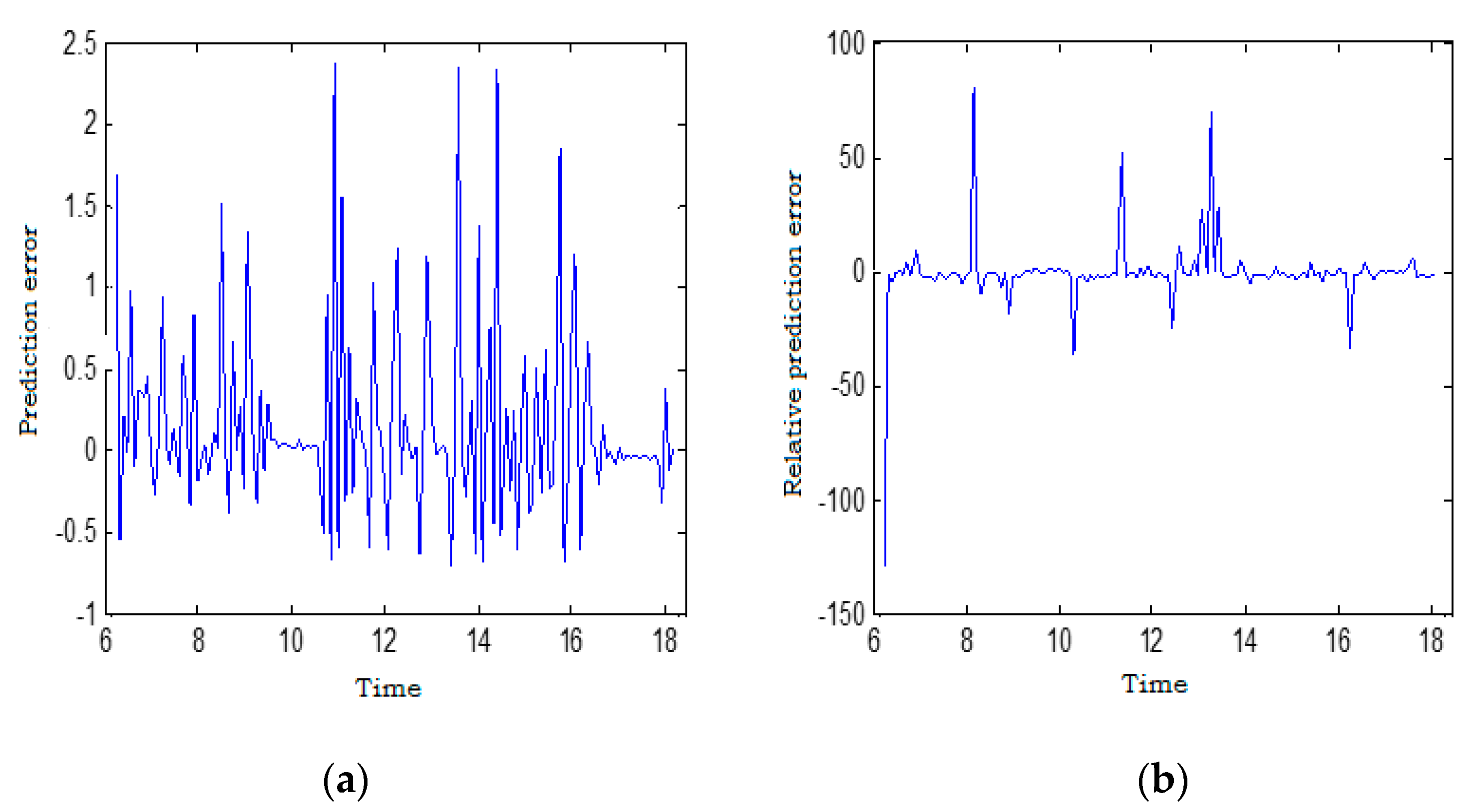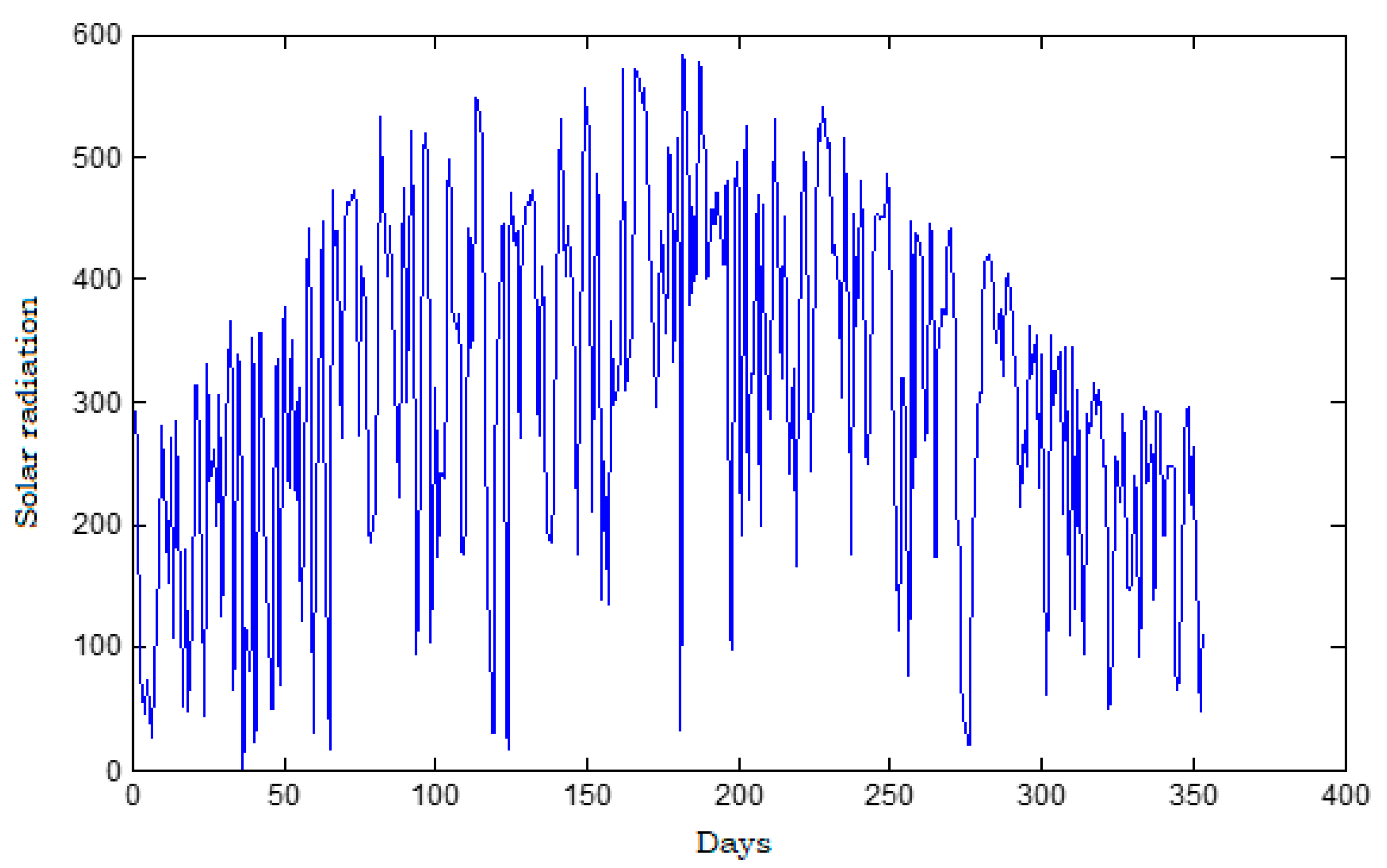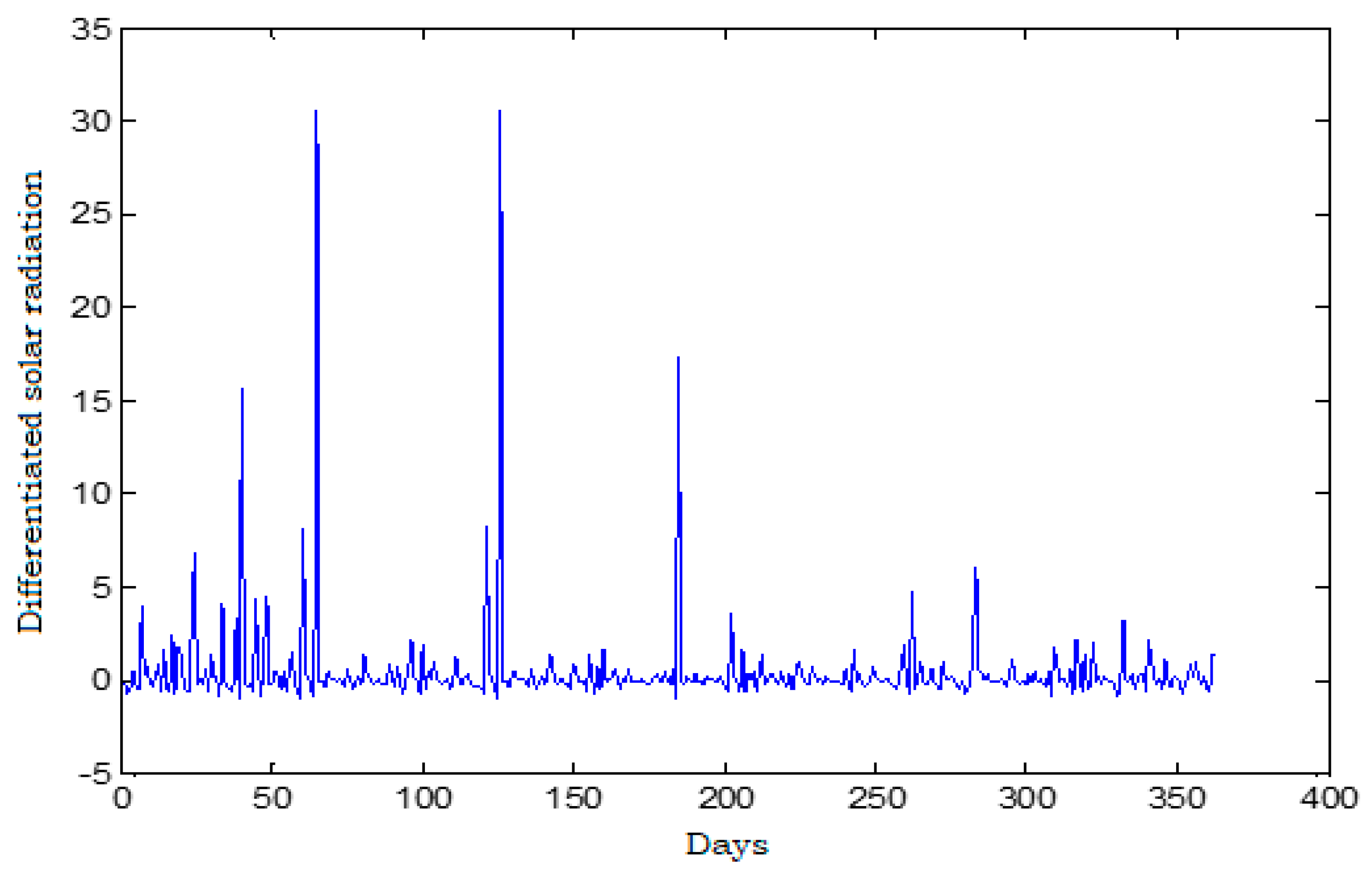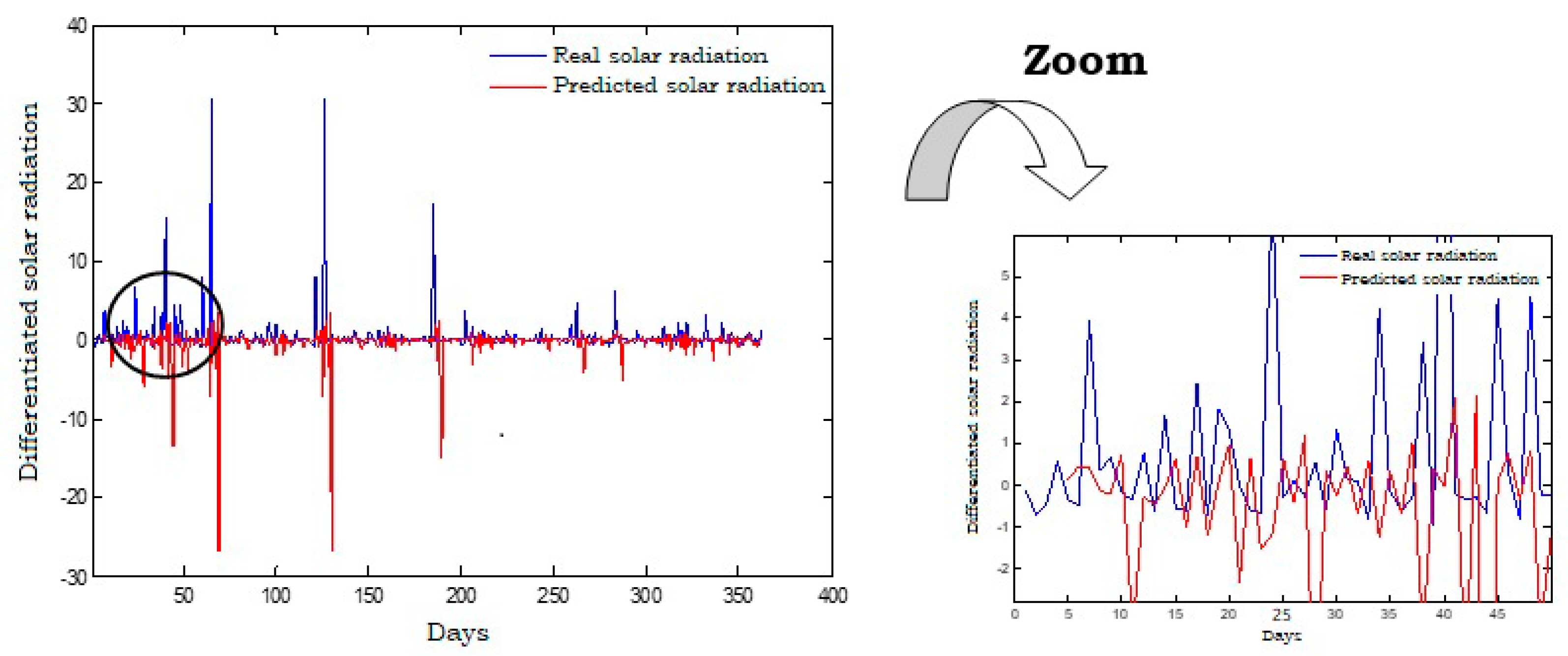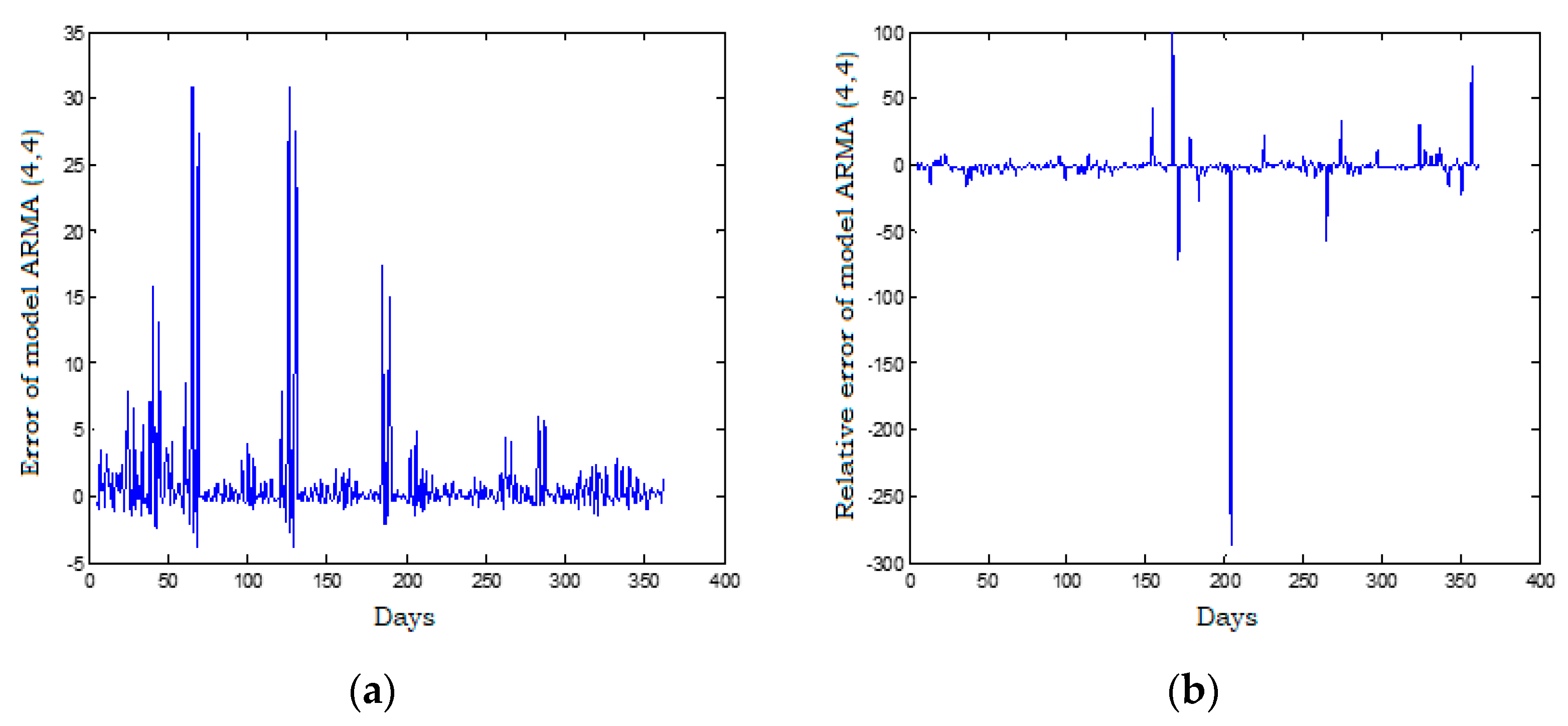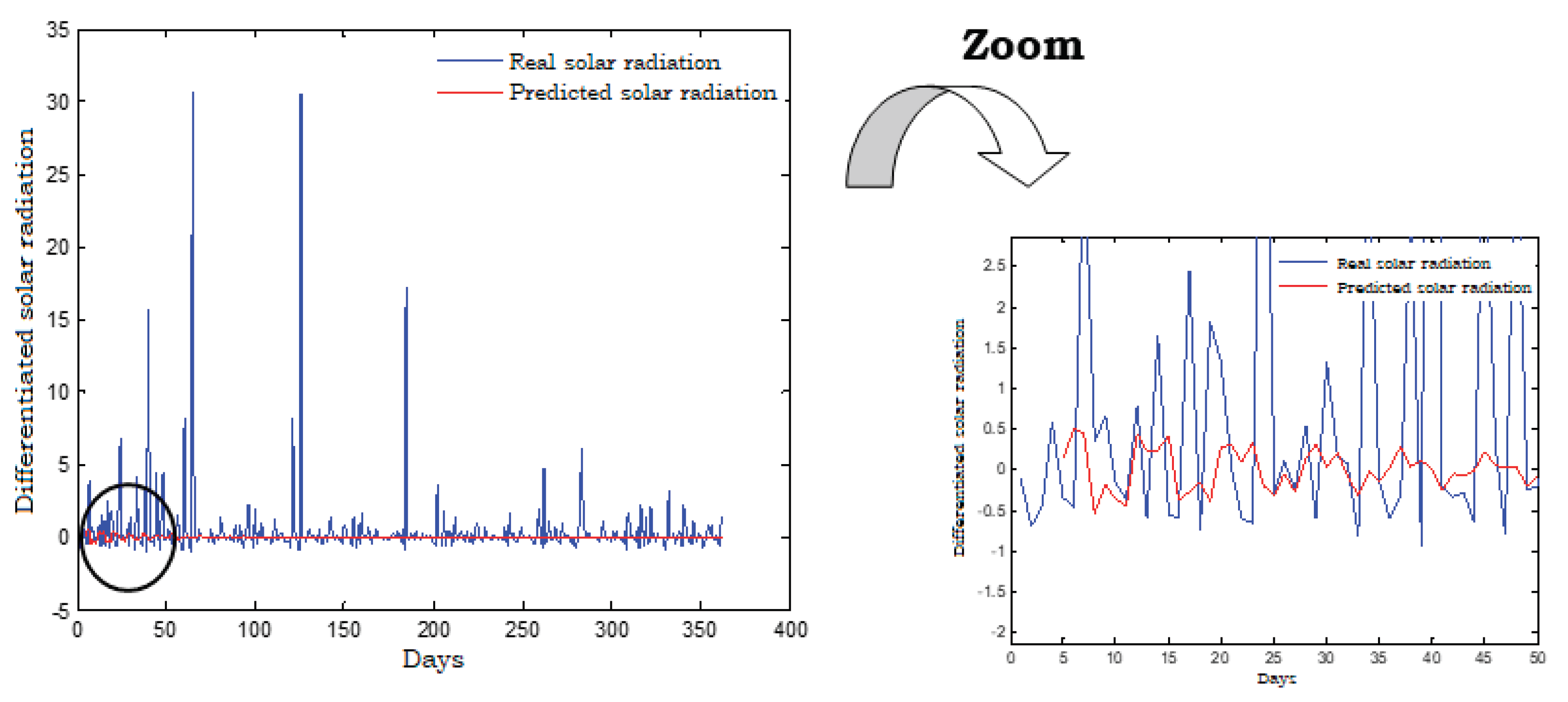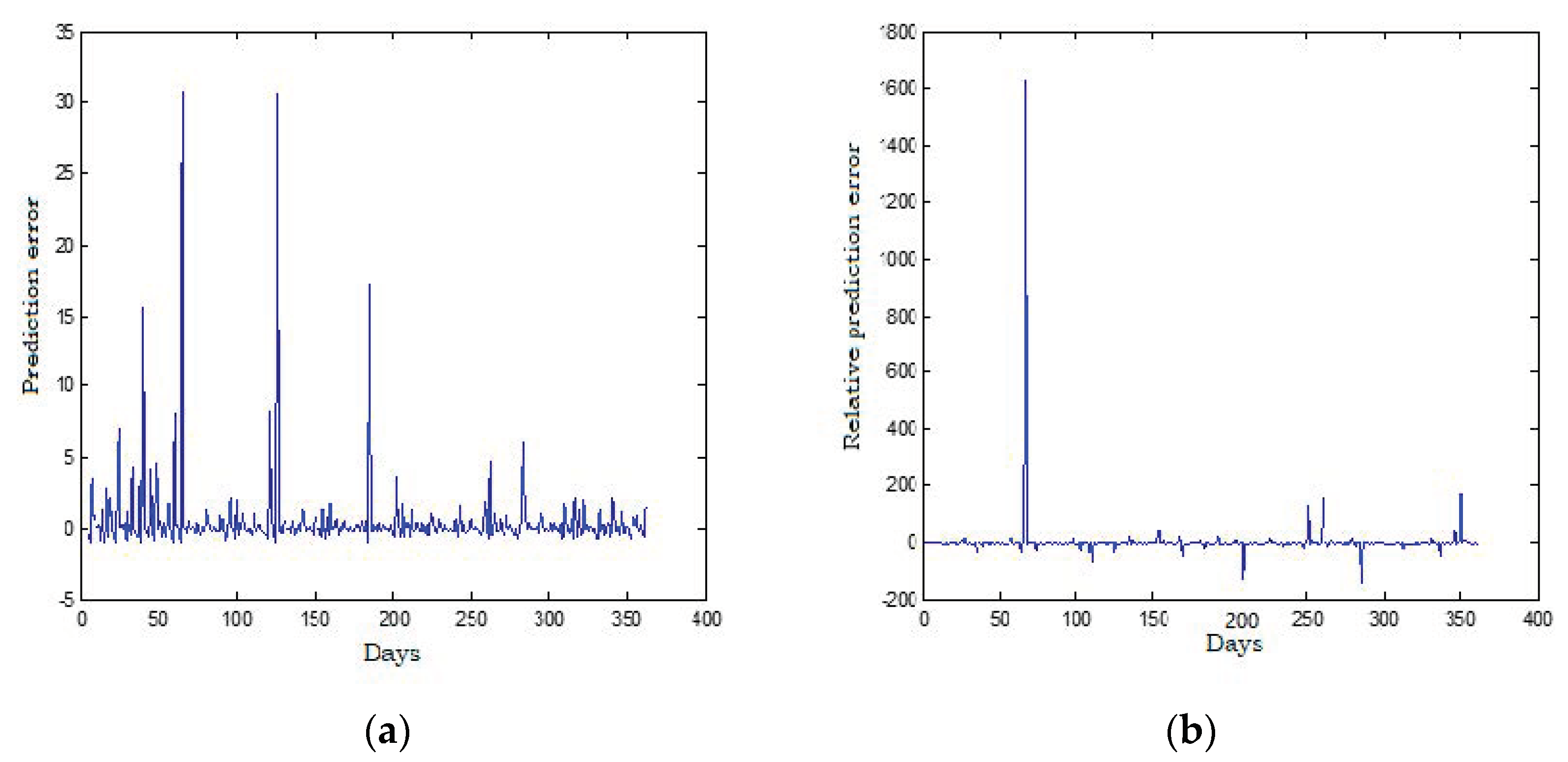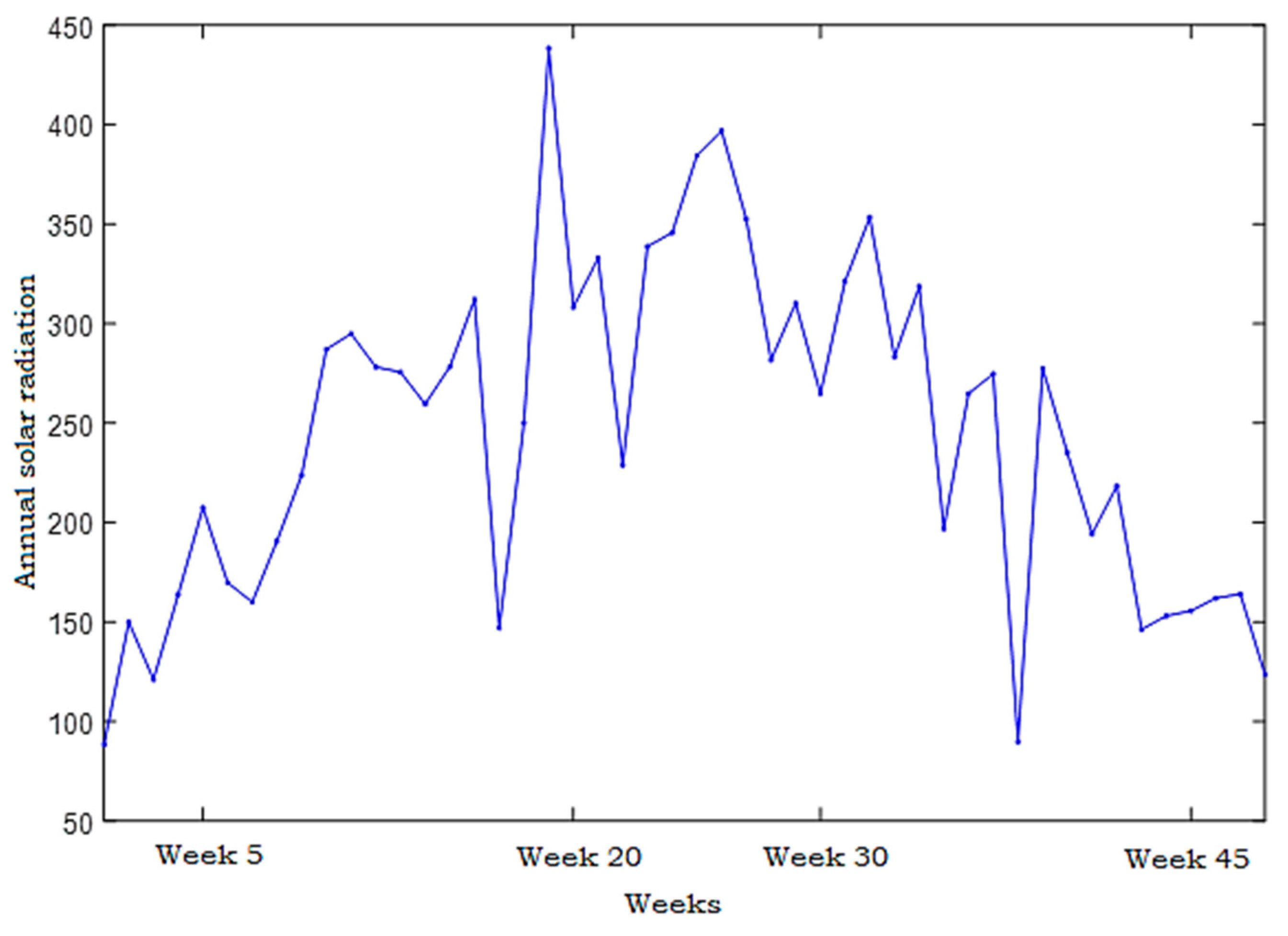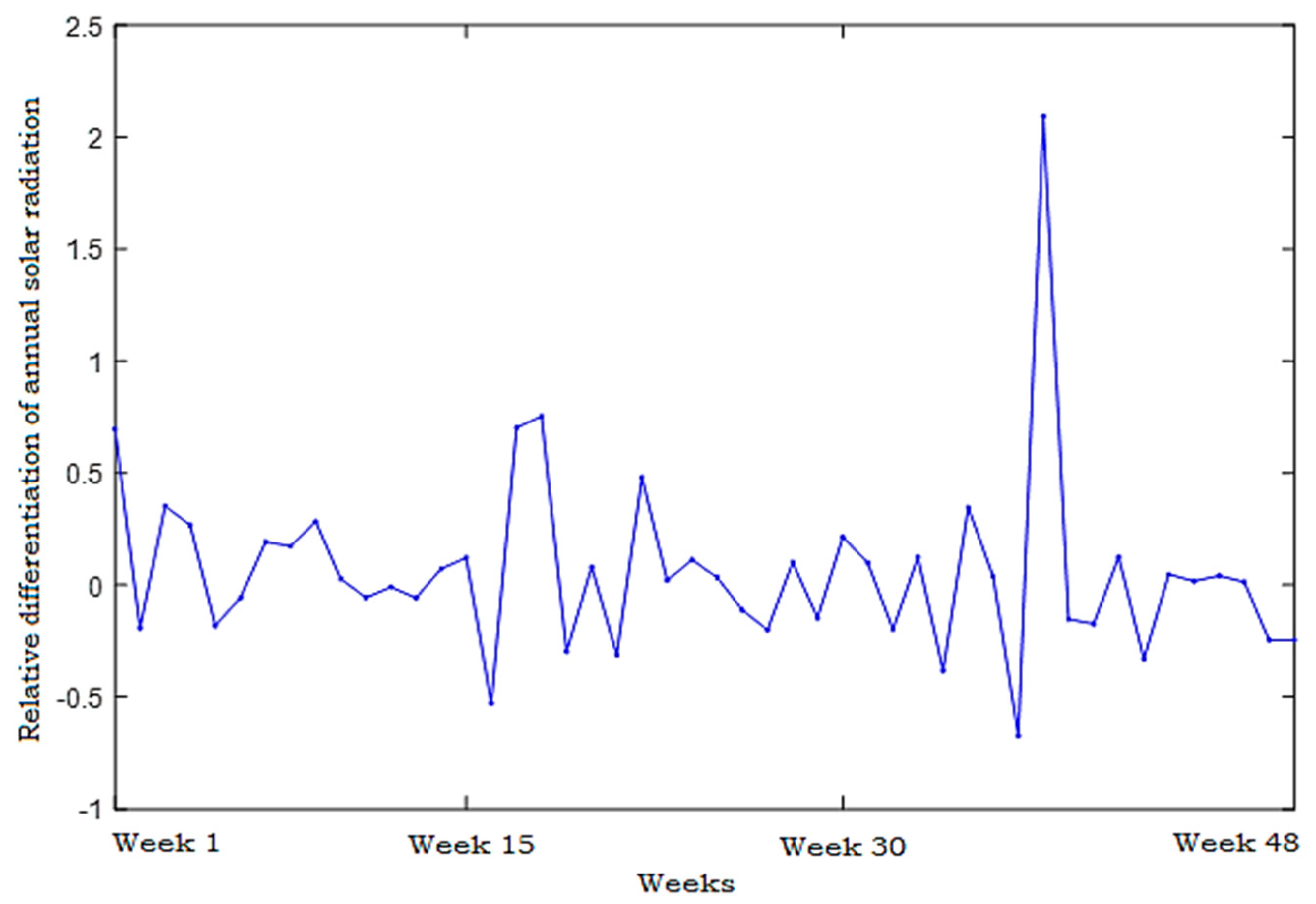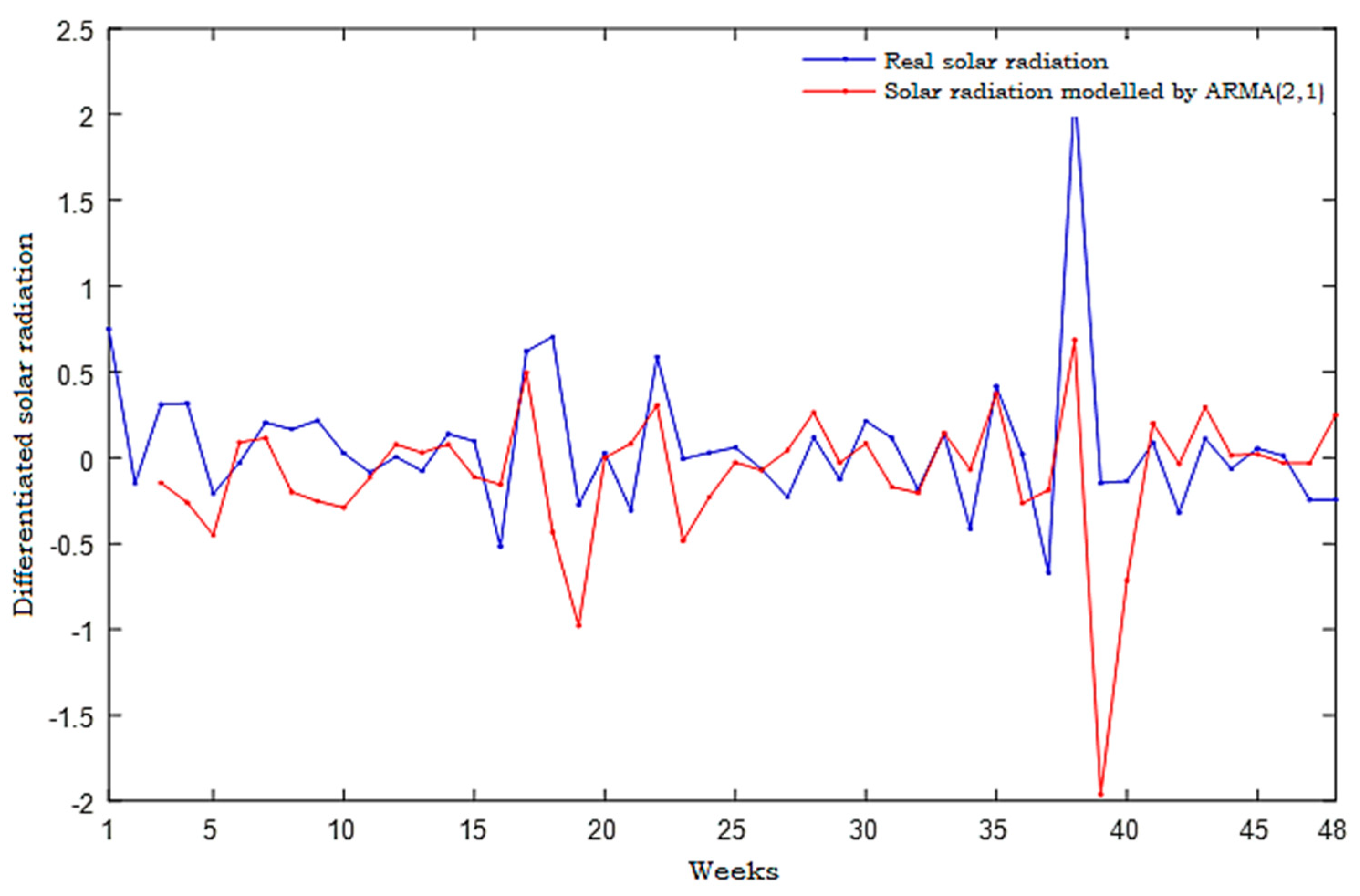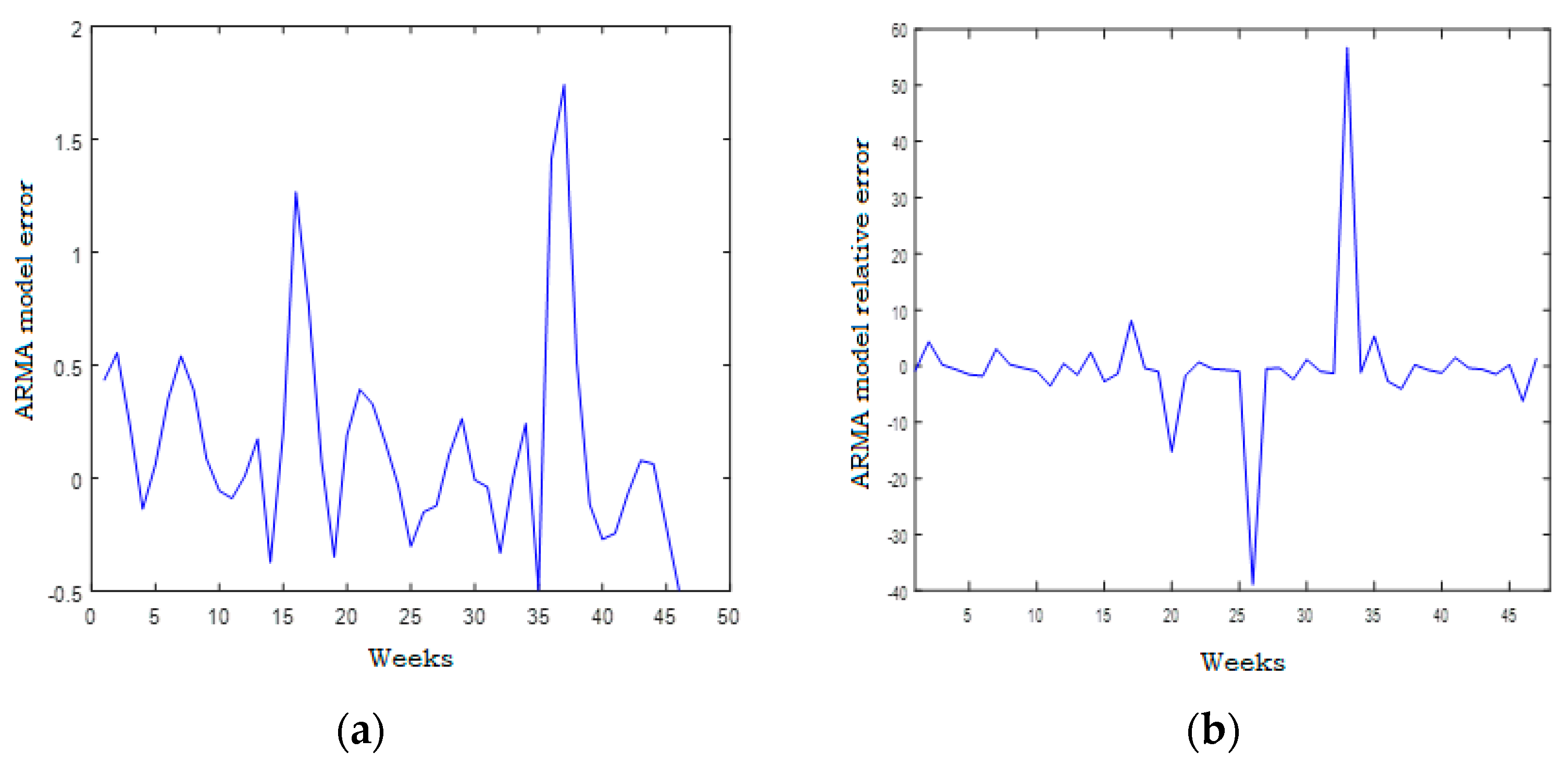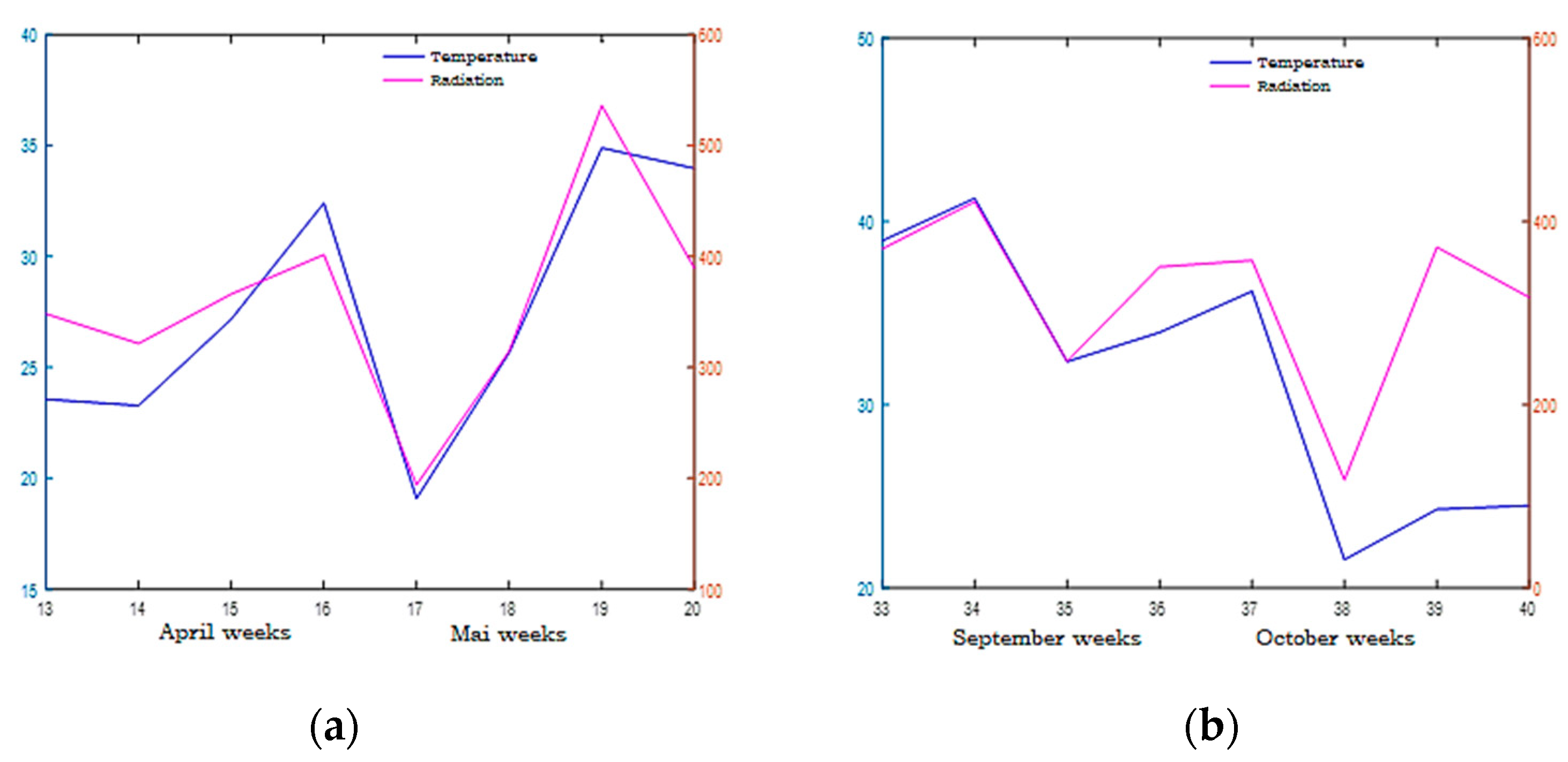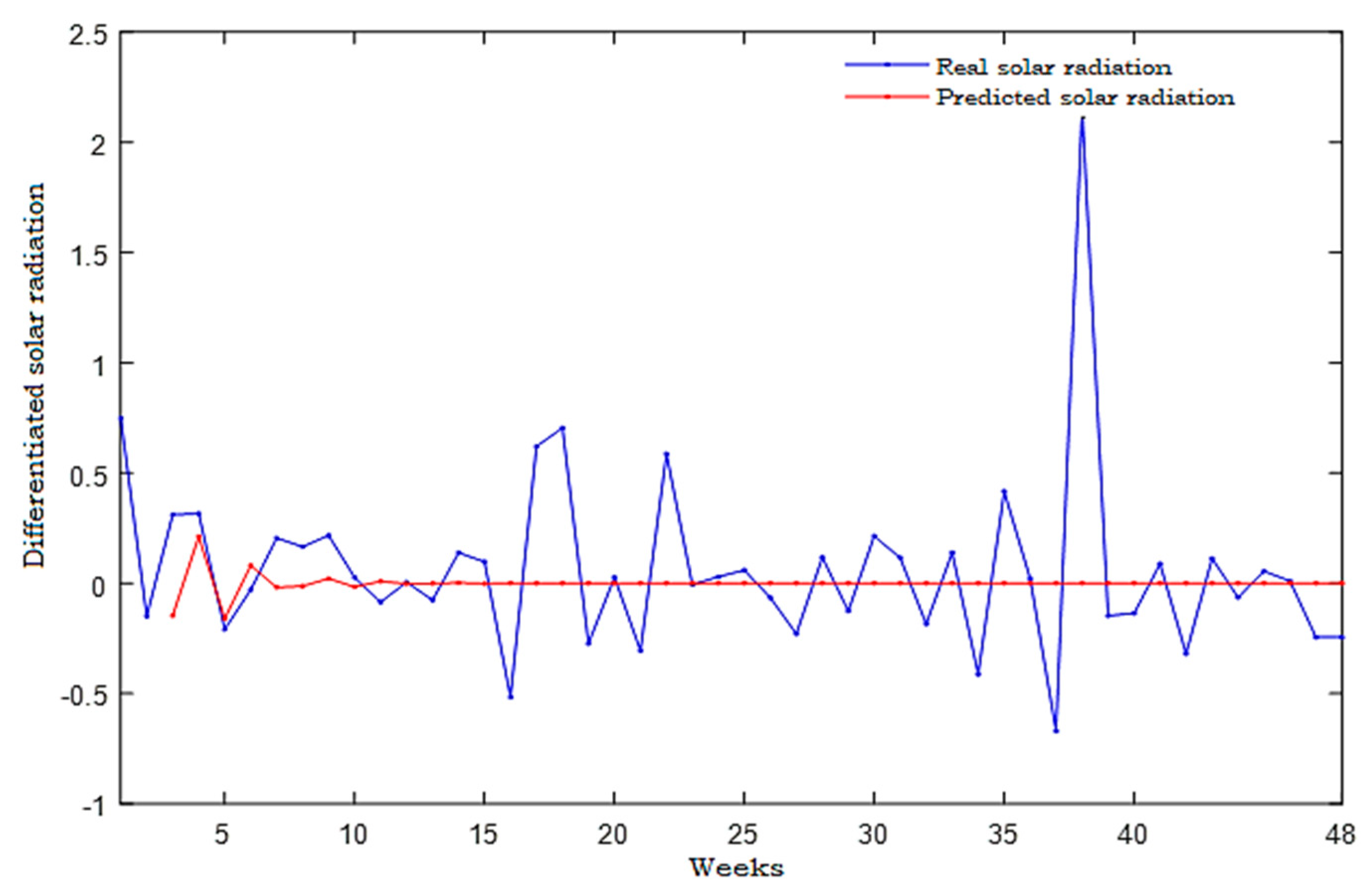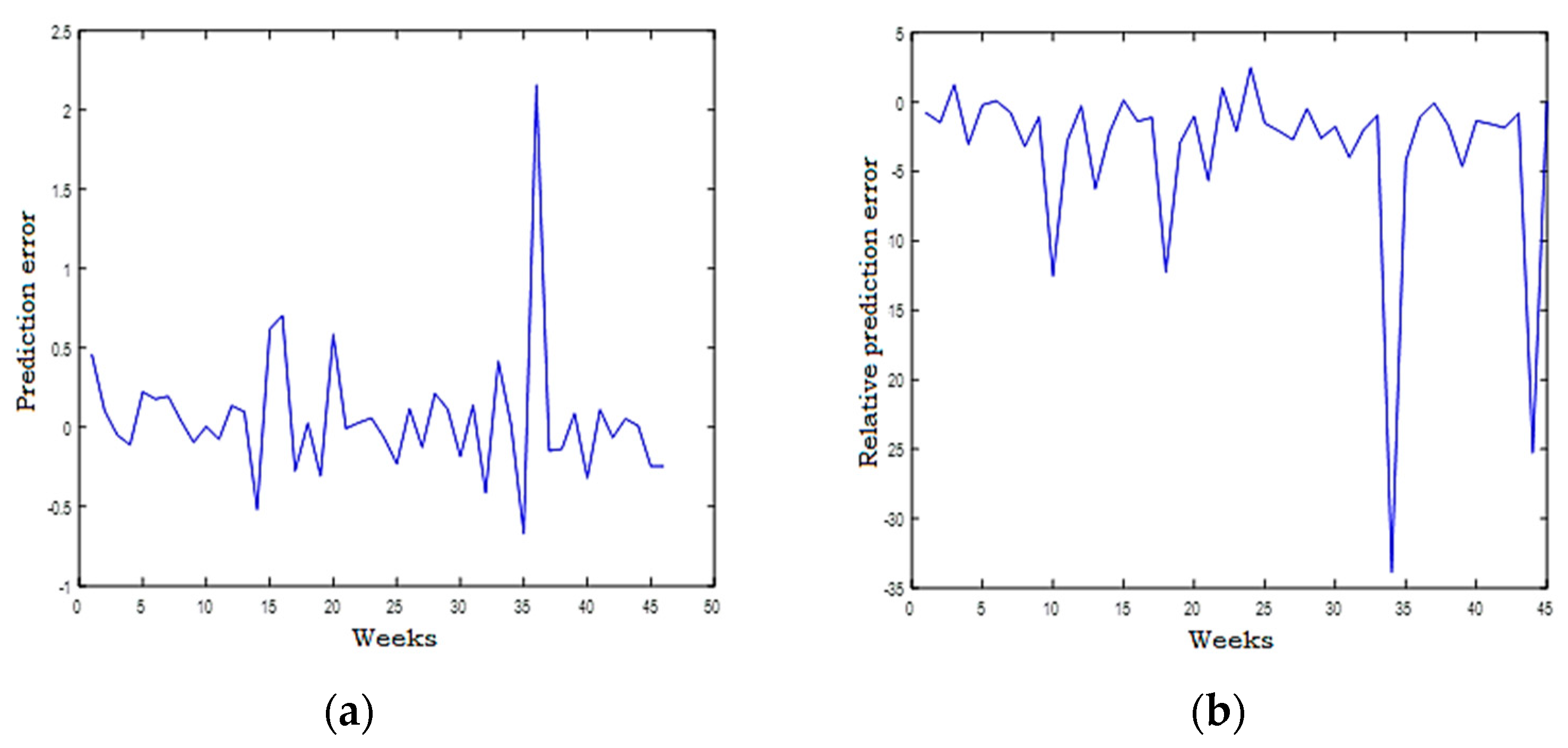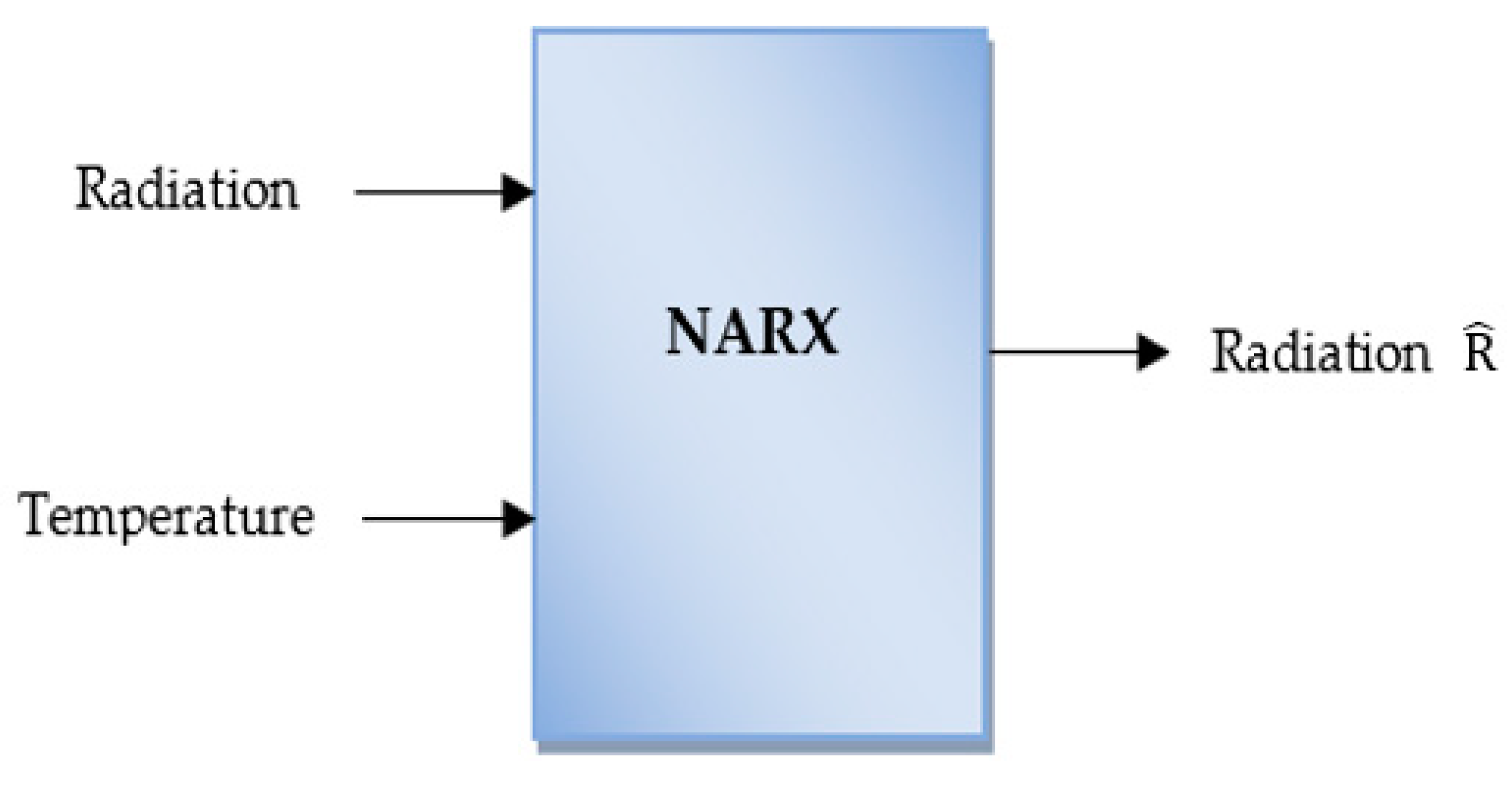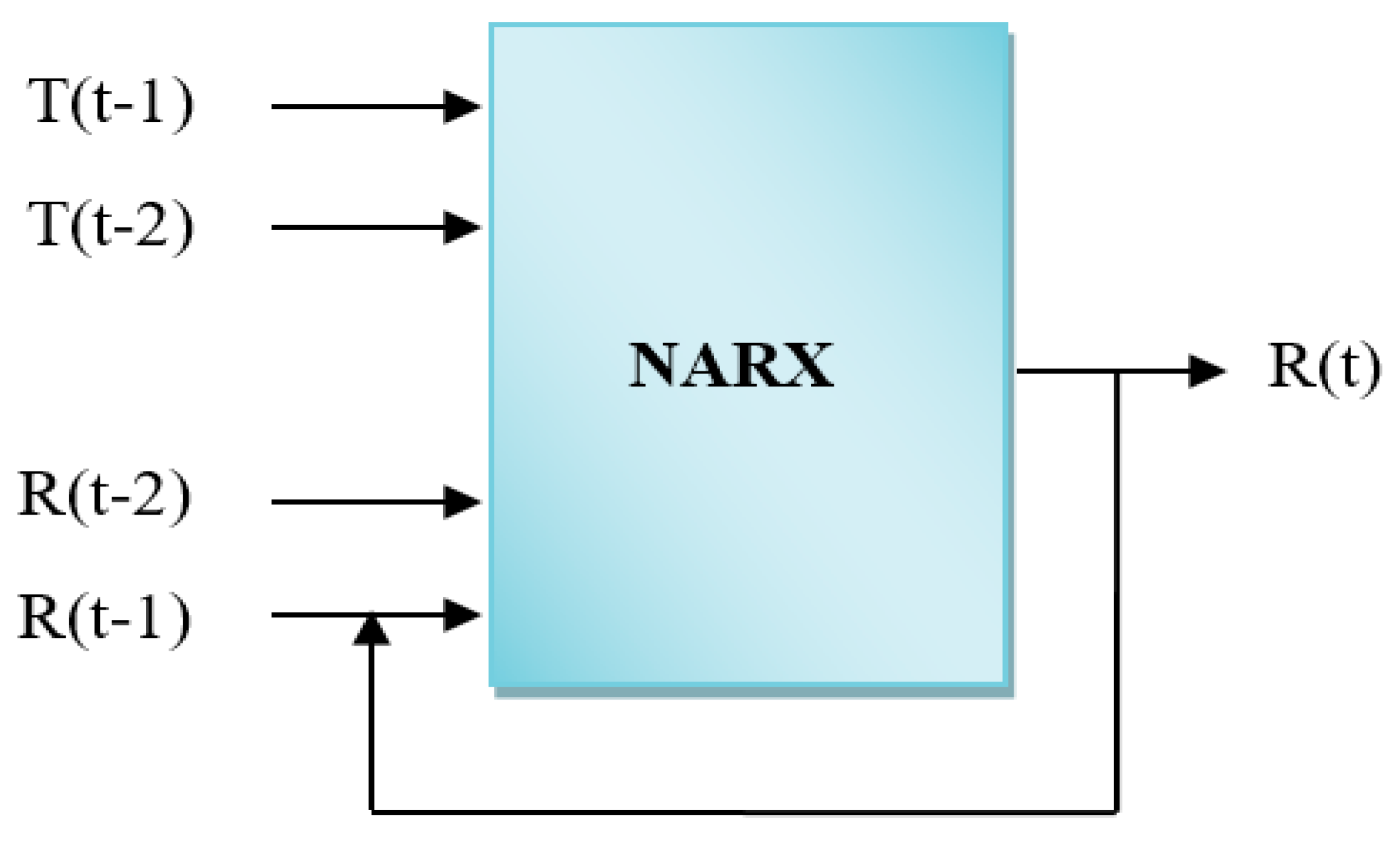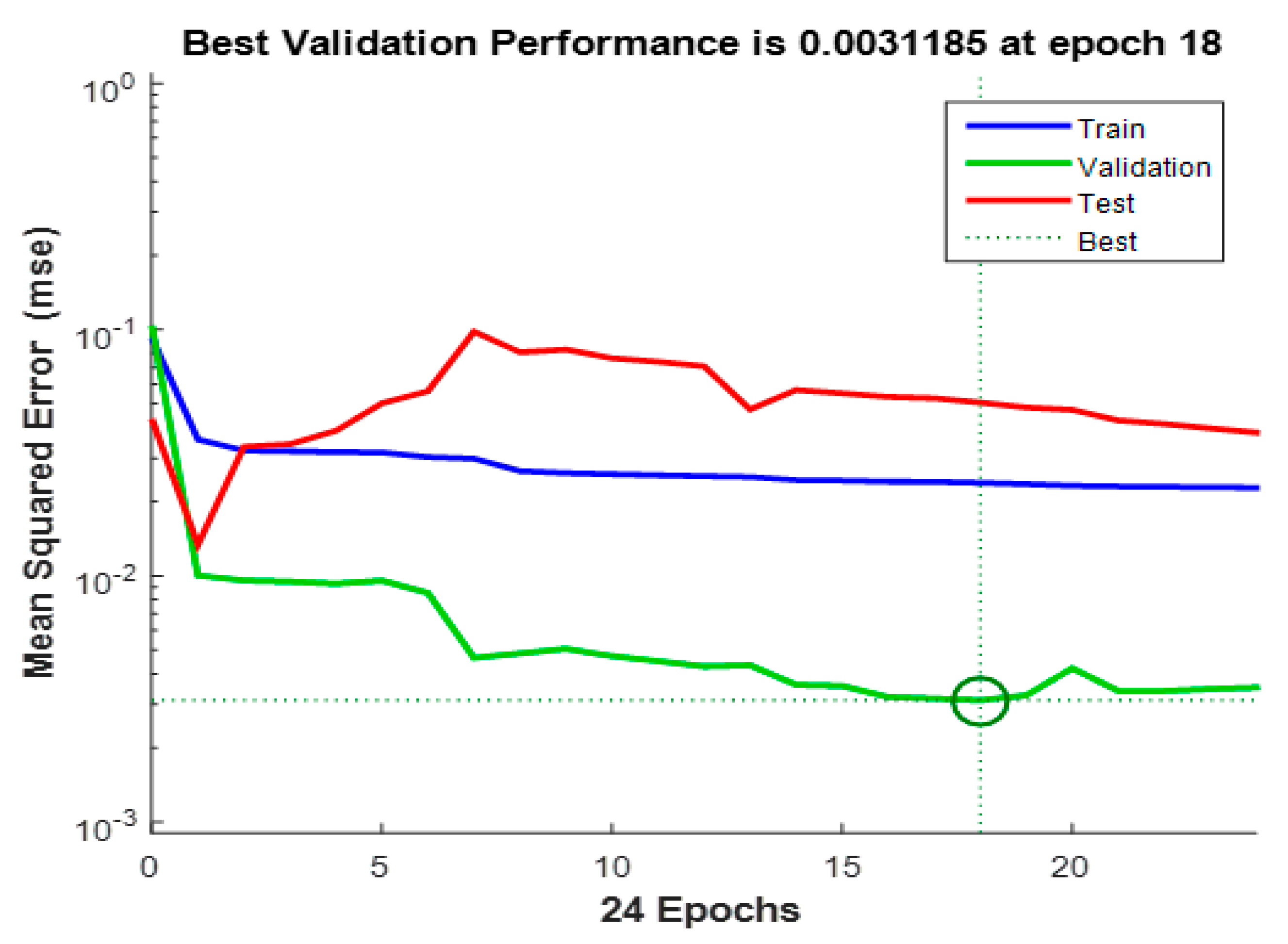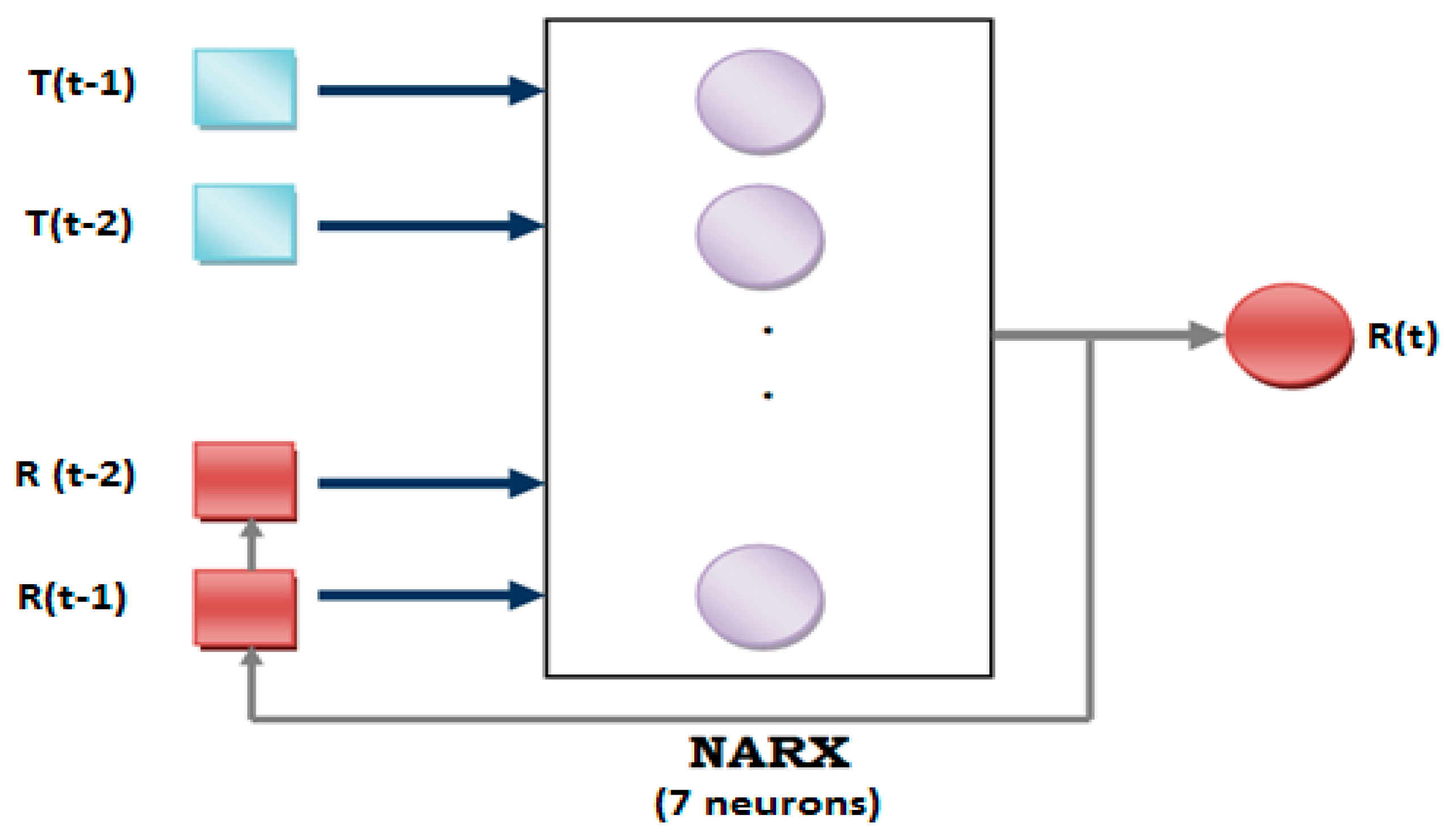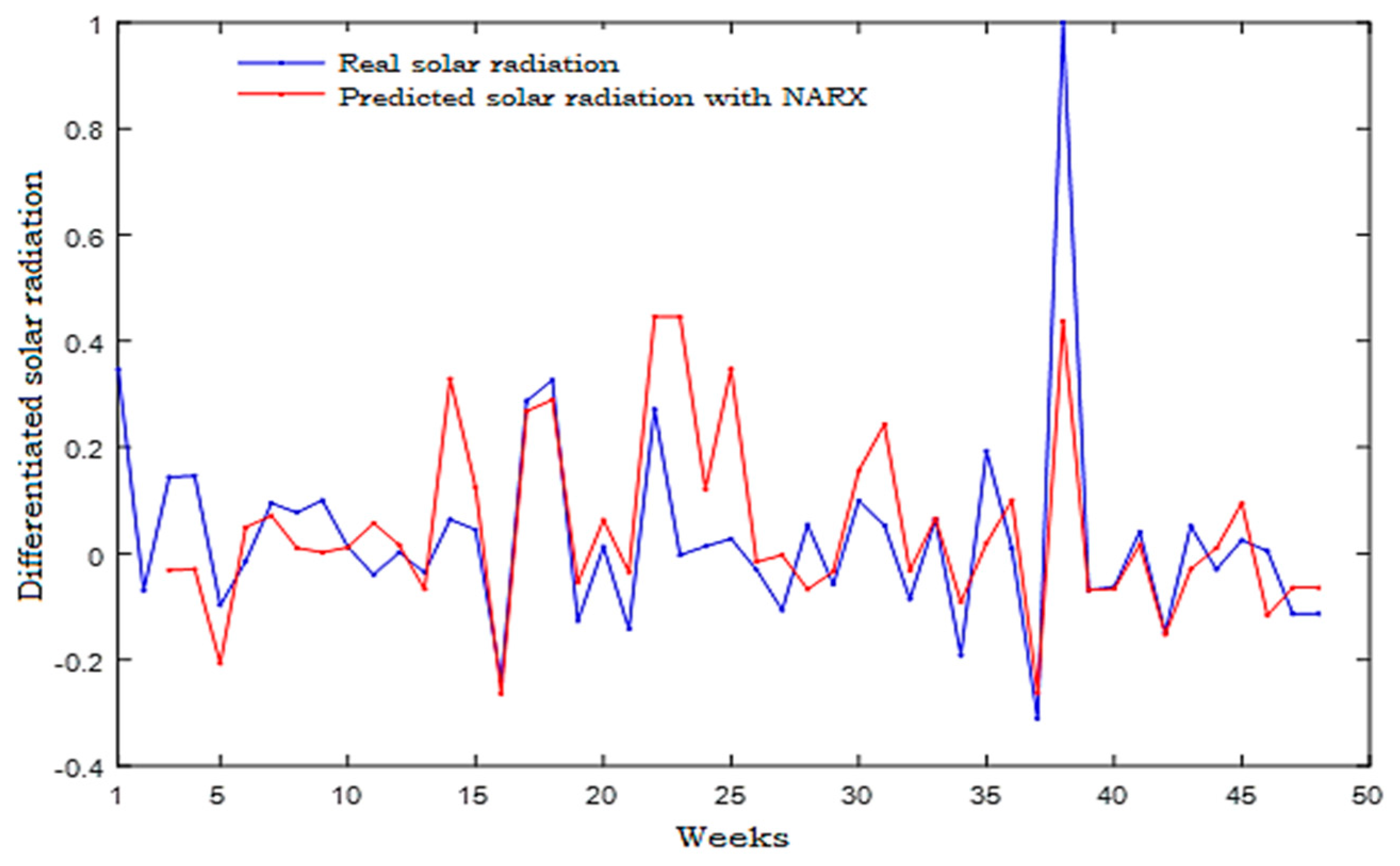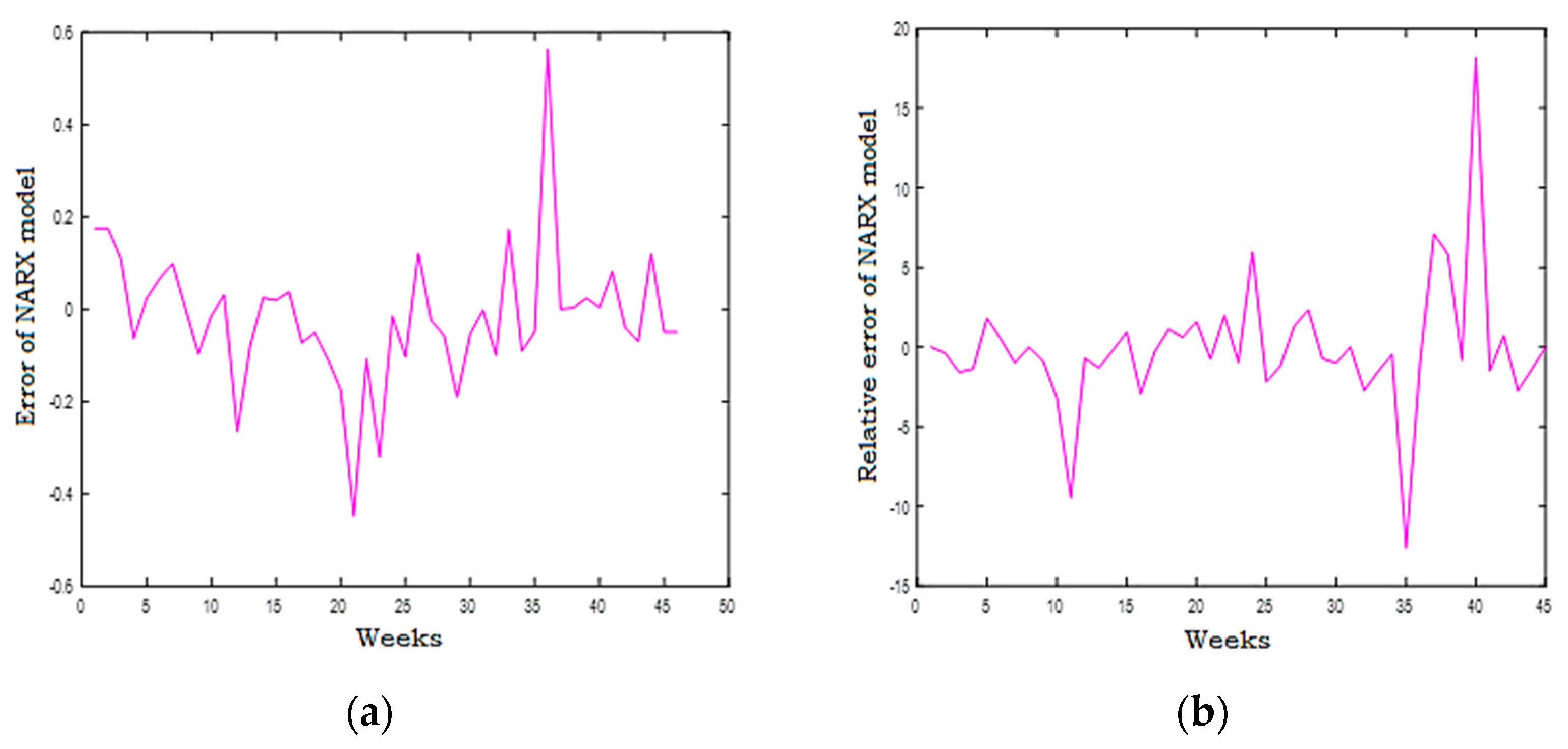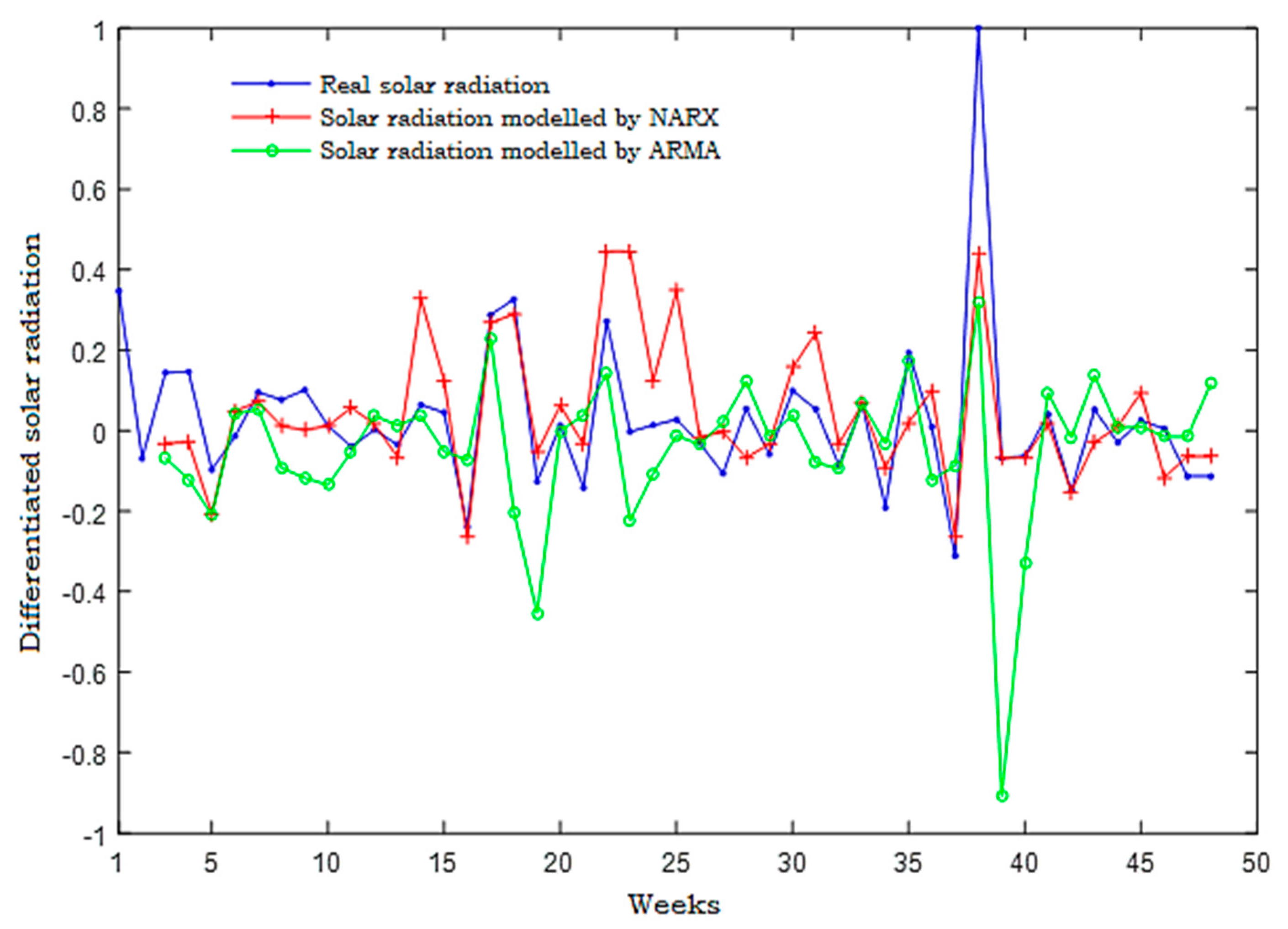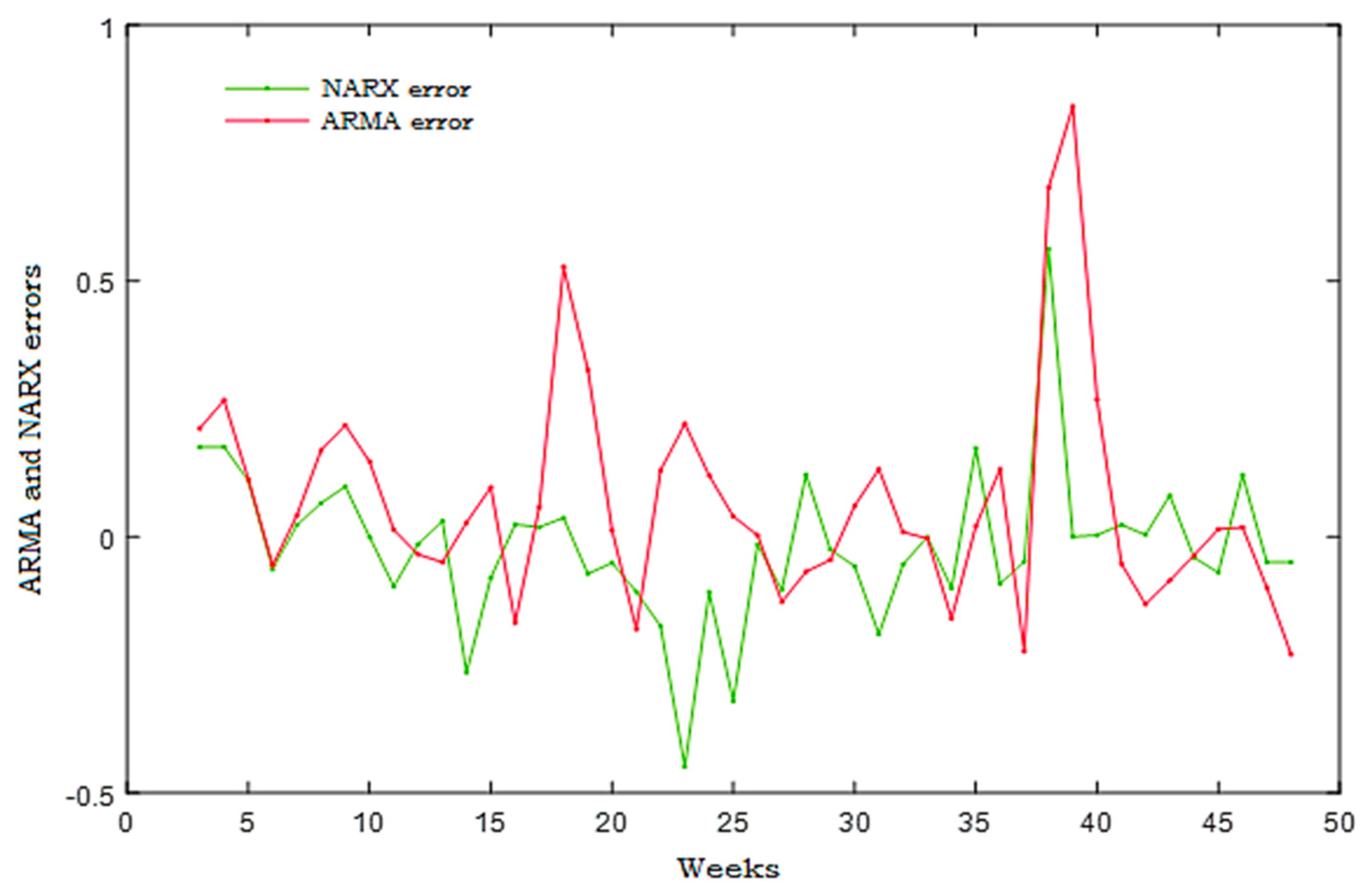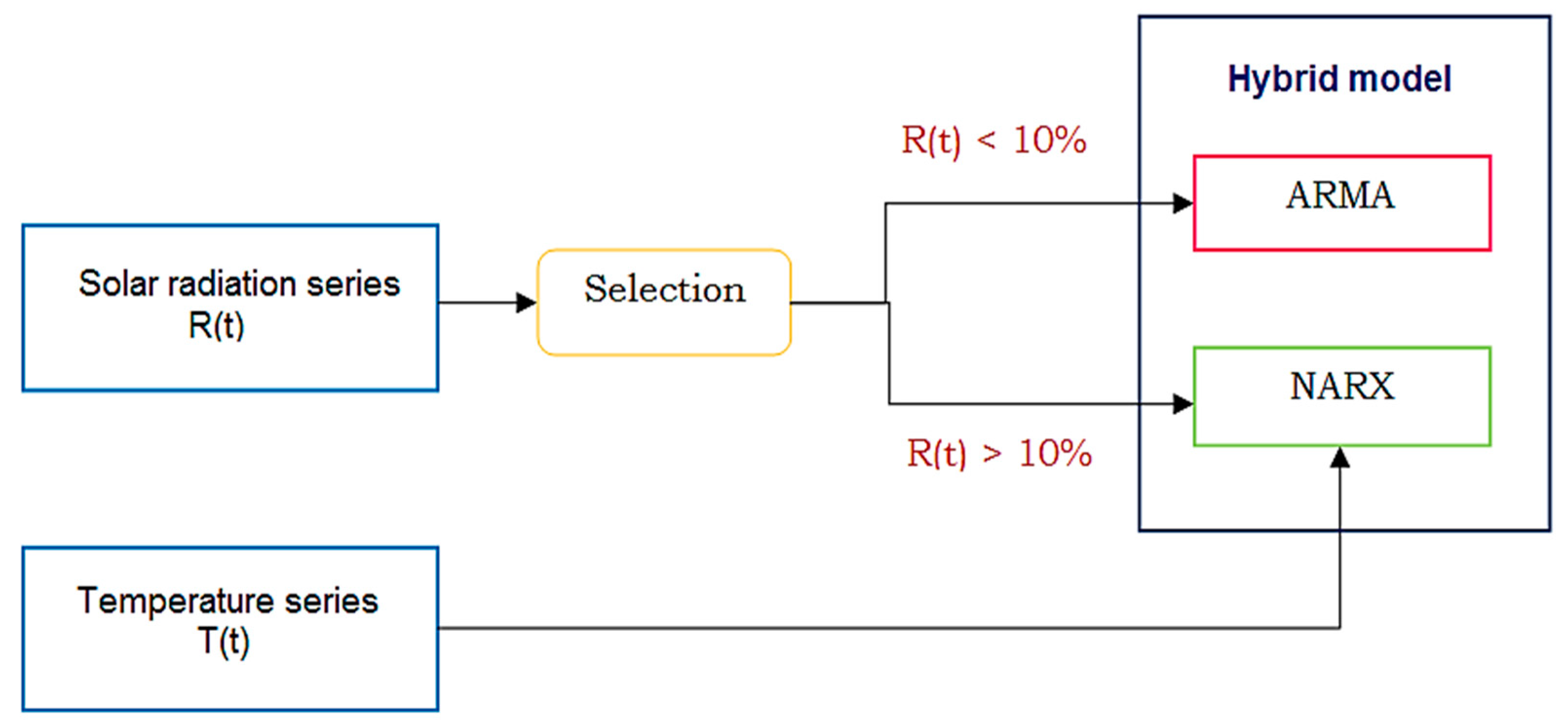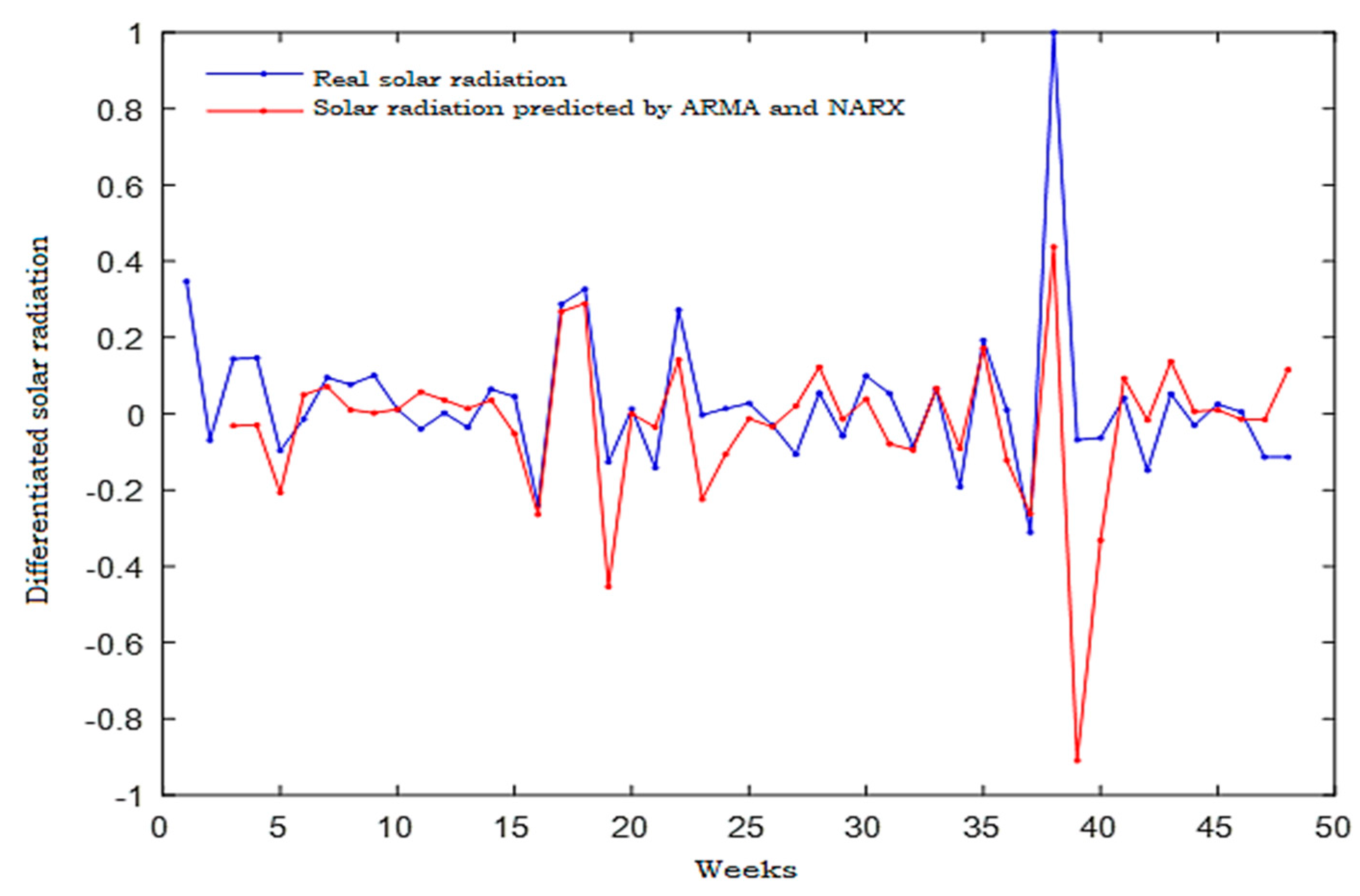In the last decades, the integration of renewable energies into the electrical grid has become the main challenge in different countries following the high consumption of electric energy in the world and the increase of oil and coal prices [
1,
2]. Furthermore, renewable energies can be the adequate solution for isolated and rural areas as well as for beacons at sea. Solar energy is among the key renewable energies, it is clean and available and it can be directly captured through a PV system. Parameters associated with electrical equivalent models of PV systems have great importance in its performance enhancement. However, the accurate estimation of these parameters represents a challenging task due to the nonlinear characteristics of the PV modules/panels and the higher computational complexities [
3,
4]. On the other hand, PV power production is mainly based on solar radiation, it is completely absent at night and available during the day, it is low in winter and high in summer and for the same day it is likely to be fluctuating because it is influenced by some weather conditions. This is the cause of PV power production intermittence which causes several problems when integrating the micro grid [
5]. To minimize and/or avoid these problems, PV power prediction, or rather solar radiation prediction represents an excellent solution. Moreover, it is important to select the appropriate prediction technique to obtain an accurate solar radiation prediction. In the literature, there are several ways to predict solar radiation; they can be broadly divided into two categories, numerical weather prediction models and statistical models [
6,
7]. The first category is based on historical data and the reproduction of several physical factors related to the atmosphere processes such as the interaction between earth and solar radiation and the radiative absorption by ozone [
8]. The other category treats solar radiation as time series and follows the evolution of solar radiation over time. Based on the historical radiation data, a model is created to characterize the behavior and the dynamic of solar radiation evolution in the past. The prediction of solar radiation on a given time is then based on the created model. This second category is the most used, in the previous few years, different solar radiation prediction approaches have been proposed. Benali et al. [
9] used the Artificial Neural Network (ANN), the Smart Persistence, and the Random Forest methods to forecast the three components of solar radiation based on the site of Odeillo in France. They showed that the Random Forest is the most efficient compared to both other methods. For h + 6 time horizon, the Normalized Root Mean Squared Error (nRMSE) is computed for these three solar radiation components, it reached 27.78% for the global horizontal radiation, 49.08% for the beam normal radiation, and 35.08% for the diffuse horizontal radiation. In [
10] authors applied a deep Long Short-Term Memory Recurrent Neural Network (LSTM-RNN) to predict day-ahead solar radiation. As input data, they introduced only temperature and humidity of six different locations. The predicted solar radiation is then used to estimate the PV power installed in a micro grid building in Golden and Colorado. Simulation results have proven the optimal operation of this micro grid over one year following the use of the proposed forecasting model. Eleven statistical and machine models were analyzed and applied in [
11] to forecast solar radiation for medium time horizon. This forecasting was performed for three different sites located in France, Odeillo, Ajaccio, and Tilos. Simulation results have proven the effectiveness of ARMA model and Multilayer Perceptron (MLP) to predict the solar radiation with weak variability on Ajaccio site. For Tilos, which is characterized by a medium variability, the ARMA and Bagged Regression Tree have given the best performances. The forecasting reliability is lower for Odeillo with higher solar radiation variability, but the best performances were obtained using the Random Forest approach and Bagged Regression Tree. Bixuan et al. [
12] presented an approach based on Gated Recurrent Unit (GRU) and weather forecasting to predict the solar radiation over a horizon of 24 h. Experimental results have shown the accuracy of this approach compared to other techniques [
12]; it reduces the Root Mean Square Error (RMSE) by 23.3% compared to Back Propagation Neural Network (BPNN) and by 11.9% compared to Recurrent Neural Network (RNN), it can also shorten the training time. A review of solar radiation prediction using an Artificial Neural Network (ANN) is presented by Kumar and Chandel in [
13], they pointed out that ANNs predict solar radiation more accurately than conventional techniques, but their performance is dependent on the input parameters introduced. Qazi et al. [
14] reviewed the forecasting of solar radiation using ANN and they concluded that their performance depends not only on input parameters but also on neuronal architecture type and the training algorithm. The research study presented in [
15] aimed to forecast the daily and monthly solar radiation in Seoul, South Korea, using the Auto Regressive Integrated Moving Average (ARIMA) model. A large amount of historical solar radiation data was used from 1981 to 2017 as a training and testing dataset. Simulation results have proven the ability of the ARIMA model to predict the daily and monthly solar radiation. These good forecasting results have been explained by the convenience, the accurate prediction, and the simple computations which characterize the ARIMA model. ARMA has been the focus of several other studies [
16,
17], it was used in [
16] to forecast the solar radiation and then compared with the persistence model. Simulation results have shown that ARMA outperforms the persistence model on the short and medium horizon. The study presented in [
17] has applied the ARMA model to predict the global solar radiation for 24 h at Dakar, Senegal. The effectiveness of ARMA has been proven in this work and it can be used as a decision support tool for planning PV solar power plant production in Senegal and its surroundings. Although these previous solar radiation forecasting techniques, especially ANN and ARMA models, are efficient for some applications, they are not suitable for some others for which high forecasting precision is required. In order to improve the accuracy of solar radiation forecasting, several researchers have proposed hybrid models. Valenzuela et al. [
18] proposed a model which combined ANN with ARIMA techniques in order to predict time series. It is proven that the obtained results using this hybrid model were improved compared to those obtained when ANN and ARIMA are used separately. Therefore, these studies have been carried out in [
19], and they have shown the efficiency of a hybrid model combining ARIMA and ANN to predict water time series. A hybrid model compound of ARMA and TDNN (Time Delay Neural Network) was proposed by Ji Wu and C.K Chan to predict time series solar radiation [
20]. This hybrid model is applied after using each technique (ARMA and TDNN) separately. The efficiency of TDNN has been proven to predict the nonlinear component of solar radiation while the ARMA model is rather better on the linear component. To further improve the prediction accuracy, the authors proposed benefitting from the features of the two models by combining them into a single one. The prediction results given by the hybrid model were improved especially for non-cloudy days. Some other hybrid models have thus been applied for the prediction of solar radiation such as wavelets combined with ANN [
21] and Marcov chains with ANN [
22]. Che et al. suggested a novel approach which combines between Kalman Filter and mesoscale numerical weather prediction technique. A dataset of two sites in Japan and China was used to validate the capability of this model to forecast day-ahead solar radiation [
23]. Halabi et al. proposed the use of an Adaptive Neuro Fuzzy Inference System (ANFIS) for forecasting the monthly global radiation in Malaysia. The maximum and minimum temperature, monthly rainfall, clearness index, and sunshine duration are used as inputs for this model [
24]. In this research work, ANFIS is also combined with three evolutionary algorithms such as Particle Swarm Optimization (PSO), Genetic Algorithm (GA), and Differential Evolution (RE). Prediction results of these different hybrid models were compared and the highest performance was given by ANFIS and PSO [
24]. A literature review of hybrid models for solar radiation forecasting is presented by Guermoui et al. [
25]. Compared to stand alone models, authors observed the high performance and the accurate forecasting of all proposed hybrid models. However, in these different aforementioned research studies the combination between models was carried out randomly without presenting any prediction strategy.
In this present paper, a novel hybrid model is proposed to predict the solar radiation, it combines ARMA and NARX. This choice is performed in order to take advantages of these two models. Therefore, a proposed prediction strategy is followed in order to predict solar radiation in an accurate and efficient way. Indeed, ARMA is applied firstly to predict the solar radiation for a given winter and summer day, then, it is used to predict the daily and weekly solar radiation averages. These different tests are performed with the objective to follow the performances of ARMA model on solar radiation prediction for different conditions and to retain the best performance results. These different tests are presented and discussed for four scenarios. The ARMA model has given the best results for the prediction of weekly solar radiation averages. To further improve these results, the NARX model is combined with ARMA to form a hybrid predictor model.
